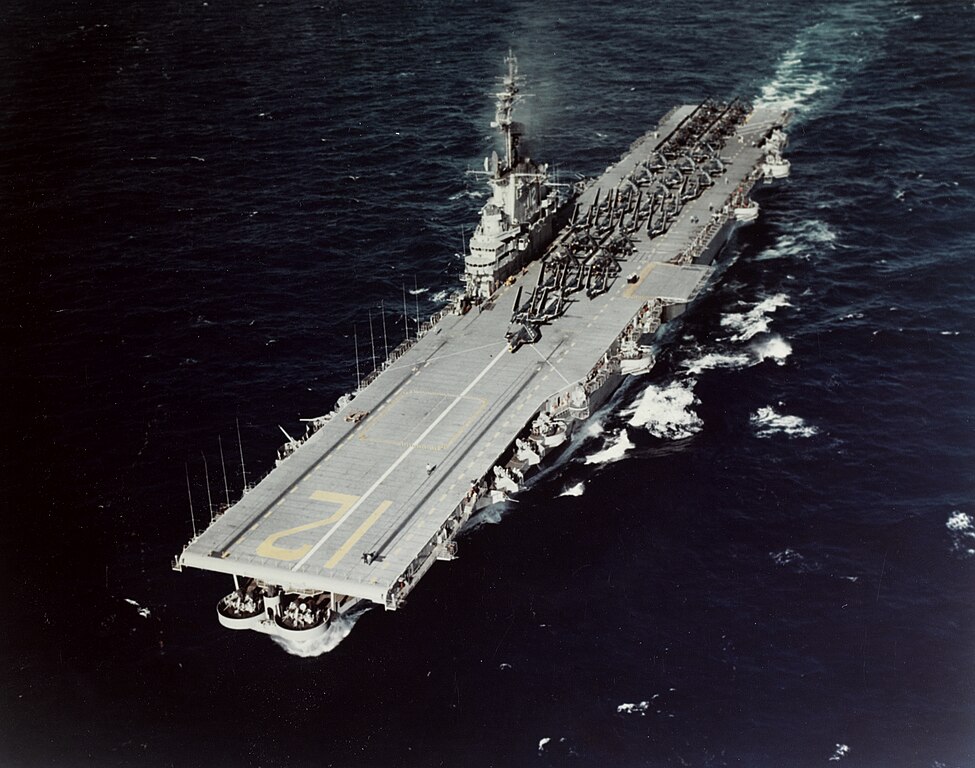
USS Hornet in 1954 in the Carribean
4 of July special ! The Essex class were a major asset as part of TF 38/58 in order to win the battle of the Pacific. However on 32 ships ordered, at V-Day, only 17 saw service, most mothballed after WW2 and the remainder unfinished being completed on a new design inaugurated by USS Oriskany. Ultimately all but two (the badly damaged Bunker Hill and Franklin) went through several modernization programmes: SBC-27A, 27C, SBC-125 and 144 (FRAM II) for some. Thanks to this, they transitioned to jet service, and soldiered on in Kore and Vietnam, the last being deactivated afterwards, and some lingering into the 1980s, four ultimaterly preserved. They contituted the bedrock of USN carrier operations for close to four decades.
One author called the Essex class “the most significant class of warships in American naval history”, citing the large number produced and “their role in making the aircraft carrier the backbone of the U.S. Navy.” 11 participated in the Korean Wa, playing a major role between attacks on ground targets, air superiority and antisubmarine patrols for the fleet. 13 of 24 also participated in the Vietnam War between the prelude and follow-up. They notably took part in a notable event in the Gulf of Tonkin when aircraft from USS Ticonderoga fired at North Vietnamese torpedo boats after closing in on an U.S. destroyer. Between the wars they projected U.S. power around the world and took part in the Quemoy and the Matsu Islands, Bay of Pigs Invasion, Cuban Missile Crisis and the last served as training carriers such as USS Antietam and Lexington. #ww2 #coldwar #essexclass #aicraftcarrier #ussoriskany #usn #unitedstatesnavy #4ofjuly #tf38
Preamble: A legendary class of carriers
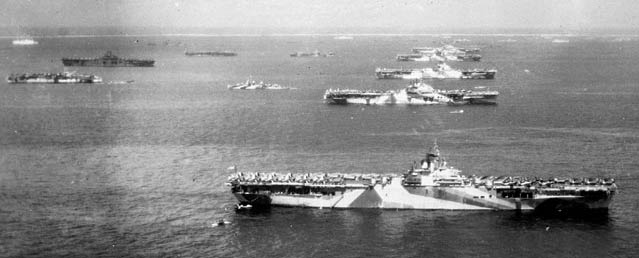
A famous photo: A fraction of TF38 (3rd fleet) at Utili Atoll on 8 December 1944, the “fast carrier task force” that ruled the Pacific in 1944-45.
The Essex class aircraft carriers where the major assets that won the war in the Pacific as part of Task Force 58/38, completety obliterating the Imperial Japanese Navy in all engagements post-1943 after the first entered service. In all, 17 ships entered service, some were bvadly damaged in operations (kamikzae attacks) and… typhoon Cobra which showed the value of a hurricane bow. The Essex class were originally just improved Yorktown class carriers when first thought of in September 1939 as the started of the war made irrelevant all naval limitations treaties. With all limitations concerning carriers through the window, the Admiralty board felt free to ask engineers at BuC&R (Construction & Repairs) and later at the Bureau of Ships when created in June 1940, what they really wanted, a fleet carrier capable of launching the “sunday punch”, a 100-aircraft strong attack as showed in wargames at the naval acaedmy.

Final plan approved for CV-9, September 1941. Very close to the previous scheme, but apparently back to 5-in/38 turrets.
This went for other modifications such as a better armour with the new STS steel composite, more secured avgaz tanks and ammunition, pumps and fuel lines, fireproofing of the hangar, more and heavier lifts and catapults to adapt to upcoming models. When ordered in July 1940, just a month after BuShips was created, based on a still very reasonable 27,000 tonnes standard making them lighter than the CV-2 class (Lexington). Three were ordered at first, CV-9 to CV-11, but after war broke out for the US in December 1941, no less than 32 were Planned in several waves, making it the largest aicraft carrier program ever, to be on par with the Casablanca class CVE (“jeep carriers”) and British 1942 light fleet program. To see all the details of the development of the Essex class:
Of this 32 carriers program it was believed the first would be commissioned by late 1943 or early 1944 and the president approve the suggestion of converting ten available light cruiser hulls into light fleet carriers as an interim. The Independence class were based on the 50+ Cleveland class light cruisers started also in 1941, but alas, they were completed just at the same time as the first three Essex-class carriers, as construction was sped up so much, USS Essex was completed in January 1943. She would not entered service for a few months however, and the whole class really reached its zenith in 1945 with at least ten operational and other about to be. In September 1945 however, the whole program was cancelled, leaving more than a dozen ships in the slipways, in various stages of completion, inclusing pre-launch stage in various yards.
This left some though decisions about either completing these ships or sent then to the scrapyard. Thus, over 32, 8 were cancelled (from early post-launch to pre-launch or even not even laid down), 24 completed, still 2/3 of the program. The design advanced in between, leading to the sub-class Ticonderoga, of the “long hull group”. After the war had ended, the Navy had on its lists an enormous fleet of proven and capable fleet carriers without purpose, but replacing the few surviving legacy (interwar) carriers such as USS Enterprise (CV-6), USS Satatoga (CV-3), and the old USS Ranger (CV-4). The CVLs (light interim carriers) were of far less utility and apart conversions, they acted as helicopter carriers (like surviving CVEs) and were retired before the Vietnam war.
But the large Essex class were just oo valuable to be scrapped. The next Midway class program was even more massive and better tailored for upcoming jets, but due to their cost, only three were built while there were projects that would lead to the massive USS United States cancelled after a brawl with the USAF over deterrence, and the new jet-capable by design supercarriers of the Forrestal class studied from 1946.
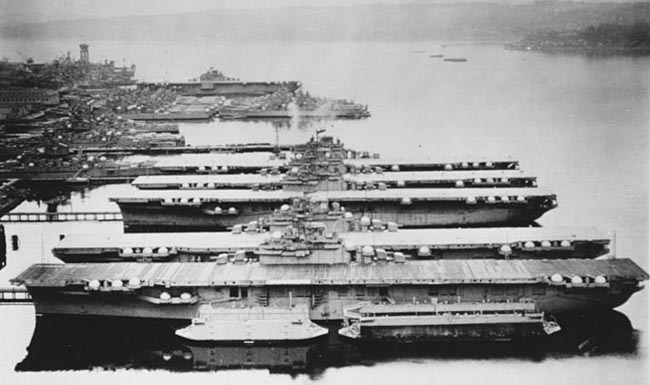
Mothballed Essexes art Puget Sound reserve, 1948
So the WW2 veteran Essex class were for the most, mothballed after carrying back home GIs in 1946 (Operation Magic Carpet). On the other hand, those carriers still in completion or less advanced saw their construction halted and the design revised with the war lessons in mind as well as better adaptation to upcoming jets, heavier and larger. In between, when the Korean war broke up and many Essexes were reactivated, modernized. The Essex class still served proudly in Vietnam as well. But this does not reflect enough how much they had been modernized, seen by the Congress in this cash-stripped decade as a good alternative to building new carriers. With the cost of upgrades, the Navy could still maintain a dozen still valuable aircraft carriers at all times, capable of operating early generation jets, late piston-engine types, and helicopters. They were seen as extremely useful and maintained as long as possible.
Design base and evolution
Base dimensions
The Essex class shared caracteristics that were later almost all altered, apart the powerplant.
Originally, the CV-9 sub-class displaced 27,208 tonnes standard for 34,881t fully loaded. Initially they measured 249.9 meters long (817 ft) at the waterline, and 265.8 meters (870 ft) overall.
The “long hull” (see below) would push this to 270.7 meters overall (886 ft). Beam was unchanged on all vessels, 28.3 meters at the waterline (92 ft) and 45 meters overall (147 ft), then 8.38 meters (26.4 ft) full load in draught.
Powerplant and performances
The Essex class unchanged feature remained the powerplant: 4 sets Westinghouse geared steam turbines fed by steam produced in 8 Babcock & Wilcox boilers. This produced an official rating of 150,000 hp which stayed the same for their hole career, provided overhauled allowed these boilers to stay sharp and proper maintenance applied to the steam turbines as well. These could bring an Essex class in its early configuration of 1943-45 up to 32.5 knots to 33 on trials, which was destroyer-rate. Of course with all the next additions, this top speed rapidly fell down to 30 knots of the SCB-27A, 29.1 on the SCB-27C, 30.3 on the SBC-125/125A. The LHC were the most modified, lossing part of their boilers (see later). The endurance figure was the best on the initial serie, at 15,440 nautical miles at 15 knots. It fell to 15,000 for all subsequent upgrades, as the addition of liquid-filled blisters only profited the addition of avgas. They carried between 4,758 and up to 6,330 tons of fuel oil depending of the completion date and modifications.
Protection
Another relatively unchanged feature for the whole class was the armpur protection: On the initial carriers, up to CV-14, all had an armoured belt ranging from 102 mm (4 inches) amidships to 64 mm (2.52 inches) in STS steel, and the hangar deck had a 64 mm (2.52 inches) floor, whereas the main deck was 38 mm (1.5 inches) thick. It seems on USS Oriskany and SBC-27A, C and SBC-125 conversion the belt was eliminated and thinned down on vital areas to 37 mm (1.45 in). The earlier LPH conversions kept their original armour.
Armament
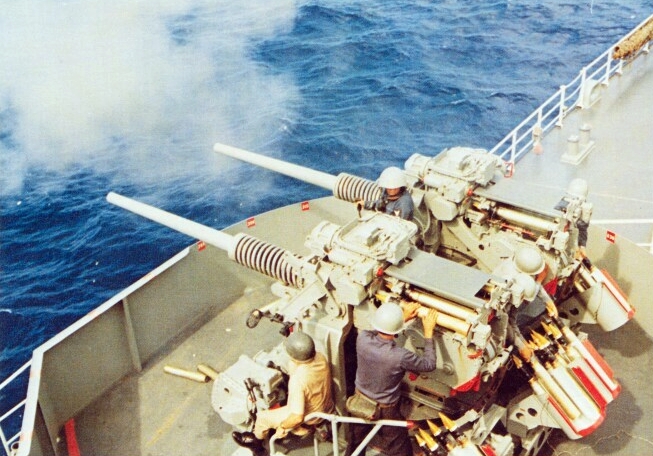
The twin 3-in/50 Mk.33 started to replace former Bofors through the first SBC-27A refits. These carriers kept some of their 3-in/38 guns active for many years. With SBC-125, only four were kept. They never transitioned to missiles for self defence.
This chapter was probably the most vivid. Originally, the Essex class came out already “buffed” with three caliber classes:
-The heavy 5-in/38 -four twin Mk 12 turrets fore and aft of the island, four Mk 12 in sponsons forward.
-Then eight quadruple 40mm/56 Mk 1.2 Bofors.
-46 single shielded 20mm/70 Mk 4 Oerlikon placed wherever there was a small spot available.
From CV-15 onwards (CV15, 20, 31, 38) still had the four 5-in/38 Mk 12 and four single, but then ten quad Bofors (two more) and Oerlikons increased to 56.
But the best was certainly CV21 (USS Boxer) which had no less than eighteen quadruple (72 total) Bofors, and thirty-five twin 20mm/70 Mk 4 Oerlikon guns (70 total) so 143 guns total to oppose to Kamikaze. This was confirmed on CV32, 33, but CV36 went down to sixteen twin and twenty three single 20mm/70 Mk 4 AA guns. That still made for 47. Thus was true for the following CV-37 to CV-47.
This decrease in 1945 reflected the lack of efficience reported of the Oerlikon against Kamikaze. It should be noted that all these guns requried massive crews. One for each 20 mm plus “flying reloaders” carrying ammunitions drums between mounts, the quad Bofors had crew of 11, and the 5-in guns had between 15 to 27 depending of the mount. In the case of CV21 to 33, this made for at least 800 extra personal. All this crowd needed to be fed and bethed somewhere.
Thus, in 1946, the armament was revised. CV-9, the lead ship for example, had its four twin turrets 5-in/38 upgraded to the Mk 32 type turrets and the four single 5-in/38 to the Mk 24 mounts. Bofors capacity was augmented to eleven quad Mk 2, and sixty-one 20mm/70 Mk 10 Oerlikon guns. This varied wildly between ships, but to take the last, CV38 USS Shangri-La she had the same but fifty-three twin 20mm/70 Mk 24 Oerlikon and seven single 20mm/70 Mk 10 for a grand total of 113 Oerlikons.
Electronics
CV9 USS Essex was completed with an earlier era electronic set, the SK, SC-2, SG radars and two Mk 4 radars fore and aft for main fire control.
From CV10, 12, and 16, 17, 18: The SM radar was introduced as well as two Mk 12.22 radars which replaced the Mark 4.
On CV13, 14, 15, 19, 20, 31, CV 38, the main surveillance radar was upgraded to the SK-2, the rest was similar to above.
From CV21 onwards, cimprising 32, 33, 36, 37, 39, 40, 45, and CV 47, the SR radar was introduced as well as the SG-6 and fore control radars of the SP, SX types and in addition to the Mk 12.22, two Mk 29 and six Mk 39 as well as nine Mk 28 radars for the AA guns, plus the TDY ECM suite.
Thos was of course massively upgraded in the following SBC programs.
Crews
An aspect which is perhaps the most striking overall, was the rise in crew, which seems counter-intuitive. See, the biggest change in naval warfare over the decades and centuries, has been the crews relative to the ship’s size. Automation in the cold war was the real game changer, but also the change in AA defence, which accounted for a massive part of the ship’s crews.
Despite their large size, the Essexes appeared “cramped” already with their WW2 crew, that is the 100+ guns requiring at least 6 crew on average, the 91-strong air crew (depending of the type 1 to 3 so 2 on average, 180+, and the support crews, at least two mechanics per planes on average so 180 to 250 more, the staff, and to all of this, was to be included the ship’s own crew, the captain and his staff, NCOs and hundreds of sailors between the machinery spaces, from radar operators to the cooks. In WW2, an Essex class went to sea with 2,682 men total.
The strange thing was the evolution of this crew through the next upgrades; Not only the number of aicraft went down, but the AA as well (all the 5-in/38 were removed, 20 mm Oerlikon were eliminated gradually as were the 40 mm Bofors, see the armament section). Electronics were improved and automated, so less personal at least on paper. However, the SBC-27 and 27A crews went to 2,905 total between officers, NCOs, sailors and air crew. Their air park was reduced to 80.
With the SBC-27C and 125 this was even worse, with on average crews 3,545 strong, so an augmentation of… 645. This seems radically counter-intuitive, as by the mid-1965 the ari park was reduced to 50 aircraft at best. The LPH (assault helicopter conversions) still had 40-50 helicopters and 3000+ crews.
One explanation is the addition of extra electronic systems, and potentially, more maintenance and “ground” crews for the aircraft, larger crews, and the practice of double crews to have a better sortie rate. But its still quite odd and if someone has an explanation, flee free to comment here.
The late “Long Hull Essex”
Also called the Ticonderoga sub-class, the were a redesign initiated in March 1943, and with visually significant chaged during construction. The main goal was to elongate and stretch the bow above the waterline, giving it a “clipper” form. This increased rake and flare in turn enabled to ibcrease the deck space and install an extra quad 40 mm mount, whereas the flight deck was slightly shortened forward to clear its arcs of fire. USS Bon Homme Richard was the last with the “short bow” design. All the remainder were called “long-bow units” starting from USS Ticonderoga. They would remained however one and a single class postwar and refits and upgrades were applied without distinctions.
Other internal changed were safer ventilation and more secured aviation-fuel systems as well as replacing the combat information center below the armored deck and the installation of a second flight-deck catapult (the hangar deck catapult was definitely eliminated as useless) and a third Mk 37 fire-control director. Some of these changed were also ported on the earlier Essexes that went back for an overhaul in 1945.
In total over 100 small and large changes were made and deocumented. HMS Intrepid for example during repairs and refit received two new H-4B flight deck catapults replacing its H-4A and in general more 40 mm mounts were installed, gradually replacing the already ioncreased 20 mm mounts. Electronics were also altered with new fighter-control radar and enlarged flag bridge for more efficient deck management operations. All produced a “jungle” of modifications and eventually all Essexes ended different in the winter of 1945.
There were two major impetus behind halting the construction of some less advanced ships in construction after V-Day: The upcoming Jets programs, which required reinforced flight decks, catapults, lifts, but also larger avgas reserves for these hungry beasts. But the move was decidedly there and nothing could stop this evolution initiated in 1944. In 1945 all belligerents had jets programs at various degree of advancement, and three had operational squadrons. Pilots which had tried these were in no doubt they would replace piston-engine models, but the latter were available in quantity and lingered for more years, in fact until the Korean war.
The F8F Bearcat, F7F Tigercat, Guardian, Mauler, Skyraider, were all of this late generationin actve service until 1949 and the legacy Essexes were perfectly adequate for these, but jets required modified Essexes or new carriers, which was not evident after all programs had been cancelled.
The second point was to digest war lessons emerging from heavy combat seen by the Essexes especially in 1945, with the near loss of USS Franklin (924 killed in action) and Bunker Hill which were repaired by never returned to service.
But also the crumbled flight decks during Typhoon Cobra. This led to a redesign of the latter, completely enclosed and called the “hurricane bow”. There was also the realization (also born from the Okinawa campaign) that 20 mm A guns were less effective than the 40 mm, leading to replacement and/or removal and work on a solid in-between the heavy 5-in/38 and 40 mm Bofors: The 3-in/50 Mark 33 AA guns. And there was the need for better, upgraded radars, with longer range, more accuracy and better displays, as well as a more efficient Central Operation, starting with the “long bow” Essexes as a base.
In the end, most Essex-class ships were placed in reserve by 1947 and only five ships completed after the war were kept in service. The most famous of these and first completed with all postwar lessons applied was USS Oriskany.
USS Oriskany (CV-34) The forerunner
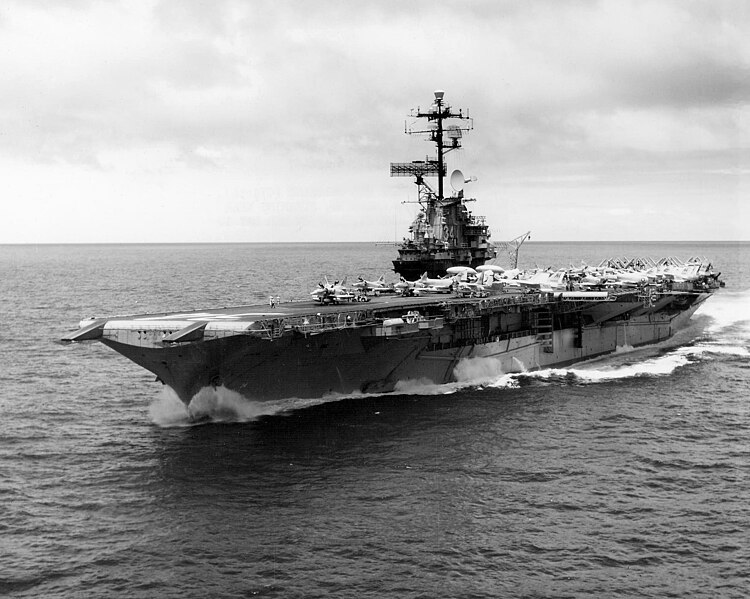
USS Oriskany off Midway 1967
The name “Oriskany” went from CV-18 renamed Wasp in 1942 from CV-34, laid down on 1 May 1944 at New York Naval Shipyard and launched on 13 October 1945. At that stage, the war was over, the Essex class program cancelled (at least te less advanced ships). She was approximately 85% complete at that stage. Construction was thus suspended, pending a decision about her fate, completion as such, modernization (thus redesign delay) or outright scrapping. This limbo went on in 1946 until it was decided to create around her a completely new redesign of the Essex class, likely to be applied to other uncompleted ships and upgrade all remaining Essexes. She became essentially the prototype for a radical list of changes registered by the Navy under the SCB-27 modernization program.
On 8 August 1947, she had bee torn down to 60% complete in order to receive the modifications. The prioritt was to be able to handle the new generation of carrier aircraft. The most pressing issue was to reinforce her flight deck structure: Not the STS armour which was left as it was, not the hangar floor, sturdy enough, but the internal pillars supporting the flight deck, to support the landing of 15 tonnes aicraft at greater speeds. The deck was massively reinforced but the next step was to have also stronger elevators (better hydraulic drive, better support) while keeping the same size, and more powerful hydraulic catapults to launched these fully loded jets, as well as concurrently, new, reinforced arresting gear to stop these.
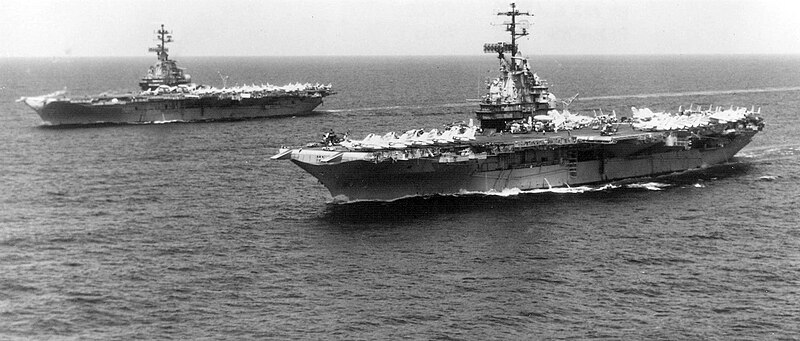
USS Oriskany and Bon Homme Richard off Vietnam 1970
The island structure was also completely rebuilt and made taller, to better support sturdier masts for a brand new radar suite. The anti-aircraft suite was not forgotten and the island fore and aft turrets removed as now inadequate against jets, the provision of 40 mm AA guns radically reduced. Blisters were added to the hull, acting as bulges to increases their cross-section and increasing buoyancy and stability, while being also filled with extra avgas volume. The main concern of engineers was indeed to avoid extra topside weight, not intended in the original 1941 design. USS Oriskany needed thus three years of hard work before being commissioned on 25 September 1950. She will also undergo the SVC-B and C upgrades, and would have a rich career in Korea and Vietnam, wich ended at the very end of the cold war when stricken in 1989 and mothballed, then sank as an original reef in 2006.
SBC-27 Upgrades
![]()
USS Ticonderoga in 1971, after her SBC-27C upgrade.
Popularly known in the navy as the “Two Seven-Alpha” or “Two Seven-Charlie” it really saved the whole Essex class from the scrapyard, also ensuring the best use of taxpayers money in a peace time context where the cold war was getting “hotter” several times. All in all, this endeavour, still costly, but less than building new carriers from scratch, allowed the fleet to keep a disposable stock of aircraft-carrying multipurpose platforms. They had well-understood limits, notably they only could operate first-gen jets, but not the heavier next ones for which the “super-carrier” fleet was created.
Displacement standard rose to 28,404 tons, fully loaded to a hefty 40,600 tons. Dimensions unchanged at the waterline and 273.8 meters overall (895 ft). The beam increased to 30.9 meters at the waterline thanks to blisters (95 ft) 46.3 oa (151 ft) at deck level. Draught went to 9.10 meters (29.5 feet).
The SCB-27A had their Main 38mm armoured deck connected with the upper edge of the 37mm armour belt and the hangar deck kept its 64 mm thickness. The underwater protection thanks to blisters was ported to 5.1m deep (167 feet). This was unchanged on the SCB-27C, SCB-125, and SCB-125A.
Armament, interestingly enough, they got rid of their Bofors well before they lost their 5-in/38 main guns:
CV9, 18, 20 for example kept their four twin turrets but their bofors were replaced by fourteen of the new twin 3-in/50 Mk 33 AA guns, radar guided and far more efficient.
SBC-27:
The sum of modifications made on USS Oriskany, namely:
1-Flight deck structure significantly reinforced to handle 52,000 pounds (23,587 kg) planes(*)
2-Stronger, larger elevators
3-Standard, but improved hydraulic catapults)
4-Mk 5 arresting gear
5-Removal of 5-in/38 turret, all 40 mm, most 20 mm guns.
6-Eight Twin 3-inch/50 gun mounts installed with prox. fuses
7-Same new clipper bow for all ships
8-New bridge island taller, but more compact
9-Brand new electronics and radar suite
10-Ready rooms (gallery deck) moved to below the armored hangar deck
11-Large escalator starboard side amidships for flight crews up
12-Aviation fuel capacity increased to 300,000 US gallons
13-Pumping cap. to 50 US gallons (189.3 L)/minute
14-Two emergency fire and splinter bulkheads
15-Fog/foam firefighting system
16-Improved water curtains + cupronickel fire main
17-Improved electrical generating power
18-Improved weapons stowage and handling facilities
19-Removal of the armor belt
20-Fitting of blisters, 8-10 feet (2.4-3.0 m) width increase
*The twin-prop North American AJ Savage as given as an example, and this allowed to carry also later the Tracker, but also the Skywarrior and F-8 crusader fighter, while they even operated in the 1970s the modern A7 Corsair II.
SBC-27A
Basically the same ported to all Essex class carriers outside Oriskany.
1-All SBC-27 modifications (two years conversion)
2-New H 8 slotted-tube hydraulic catapults.
Electronics wise, they carried the following:
CV9, 18, 20, 34 had the SPS-6, SR, SX, and the new SPN-6, SPN-8 radars plus four Mk 25 FCS and their Mk 35 radars plus the more advanced SLR-2 ECM suite.
CV10, 12, 15, 33, 39 obtained the SPS-8 instead of the obsolete SX radar.
SBC-27C
This concerned CVA-11, 14, 19 and later CVA-16, 31, 38. Standard displacement rose between 29,601 and 30,580 tonnes for 41,944 to 43,060 tonnes fully loaded (the heaviest this class ever reached), with dimensions unchanged but for the waterline blisters up to 31.5 meters (101 feet) and overall at deck level due to the better angle, at 50.8 to 50.9 meters or 165-165 feet.
On average they carried 80 aircraft, kept eight 5-in/38 Mk 24 guns and eleven twin 3-in/50 Mk 33 AA guns. This was true for CVA11, 14, 16 and 31.
This uograded consisted in the following:
1-Installation of two 2 C 11 steam catapults (first four on Hancock and Ticonderoga, were British-built).
2-Larger bulges abeam fitted (103 vs 101 feet): 43,060 vs 40,600 tons
3-Installation Jet blast deflectors
4-Deck cooling
5-Fuel blending facilities
6-Emergency recovery barrier
7-Storage and handling for nuclear weapons
8-No. 3 (after) elevator moved to the starboard deck edge (further aft on the first three SCB-27C)
In general 27C ships could handle much larger jets (except the massive Vigilante), and acted as regular attack carriers in Vietnam. S27A whips were relegated to ASW patrols.
Those concerned were USS Hancock (CV-19), USS Intrepid (CV-11), USS Ticonderoga (CV-14), USS Shangri-La (CV-38), USS Lexington (CV-16), and USS Bon Homme Richard (CV-31).
Electronics wise, they had the SPS-12, SPS-8, SPS-10 radars. Fire control systems still used the dependable Mk 25 coupled with Mk 35 radars for the 5-in and 3-in batteries and the SLR-2 ECM suite.
SBC 125
SCB-125 was the United States Navy designation for a series of upgrades to the Essex class of aircraft carriers planned by the Ship Characteristics Board and conducted between 1954 and 1959. These upgrades included the addition of an angled flight deck and other enhancements (such as with catapults and elevators) aimed at improving flight operations and seakeeping.
The SCB-125 modifications included the following:
-Angled flight deck
-Enclosed hurricane bow
-Mirror landing system
-Mark 7 arresting gear
-Primary Flight Control moved to aft end of island
-Air conditioning
-No 1 (forward) elevator lengthened (SCB-27C ships only)
-No 3 (aft) elevator moved from centerline to starboard deck edge (on SCB-27A ships; had been part of SCB-27C refits)
The SCB-125 upgrade program was applied to the final three Essex-class under SCB-27C modernization while still in the midst of their original refit. SCB-27 ships underwent all the SCB-125 modifications, except USS Lake Champlain. The existing structure was barely modified but details modificaitons needed 6 to 9 months versus 2 years. This modernization was independent from the SCB-27A/C H 8 hydraulic or C 11 steam catapults, mostly due to machinery space limitations. The SBC-27As never received for example the enlarged No. 1 forward elevator.
The first three 27C so upgraded to SBC 125 were USS Hancock, Intrepid and Ticonderoga: All had their No.3 elevators moved from the centerline to the starboard deck edge relatively far aft to clear off the deck. The next three, USS Shangri-La, Lexington and Bon Homme Richard went under the double 27C/125 modernization concurrently, and saw the same elevator relocated to a deck-edge position farther forward, which was repeated for the CBC27A under SCB-125.
USS Oriskany, the single SCB-27 converted vessel was the last one under SCB-125 and received more enhancements than any othr Essex class carrier:
-She received an aluminum flight-deck cladding
-Mk 7-1 arresting gear were installed
-C 11-1 steam catapults were installed
She thus became the one and only SCB-125A ship.
SCB-125 Modernization (Phase 1: 1951-1955)
Applied to CV-16, CV-31, CV-38 or USS Shangri-La, USS Lexington, USS Bon Homme Richard (CVA-31):
SCB-27C (Phase 1) and SCB-125 (Phase 3) and enlarged forward centerline elevator (70 ft.3 in)
SCB-125 Modernization (Phase 2, 1955-1957)
Applied to CV-11, CV-14, CV-19: SCB-125 (Phase 3), plus enlarged forward centerline) elevator to 70 ft.3 in.
These were USS Intrepid (CVA-11), USS Ticonderoga (CVA-14) and USS Hancock (CVA-19)
SCB-125 Modernization (Phase 3, 1951-1957)
Applied to CV-9, CV-10, CV-12, CV-15, CV-18, CV-20, CV-33:
-New angled deck
-Enclose “Hurricane” bow
-Improved Mk 7 arrestor system
-Air conditioning in some spaces
-Strengthened crash barriers
-Primary flight control (PriFly) relocated aft end of the island
-Improve island soundproofing
-Improve deck lighting and refreshed markings
Concerned the
USS Essex (CVA-9), USS Yorktown (CVA-10), USS Hornet (CVA-12), USS Randolph (CVA-15), USS Wasp (CVA-18), USS Bennington (CVA-20), USS Kearsarge (CVA-33) and USS Bon Homme Richard (CVA-31), USS Shangri-La (CVA-38)
Last and single SCB-125A:
USS Oriskany (CVA-34), converted at Hunters Point between Jan 1957 and May 1959.
Electronics wise, they carried the following, not at the same time, that depended on each carrier:
SPS-10 radar
SPS-12 radar
SPS-8 radar
SR radar
two Mk 25 FC (plus Mark 35 radars)
SPN-6 radar
SPN-8 radar
SPN-12 radar
SLR-2 ECM suite
SBC 144
The SCB-144 program was the Fleet Rehabilitation and Modernization (FRAM) II applied to some ships in the the class from 1965 onwards. It was austere and comprised the following:
-Installation of the SQS-23 bow sonar dome
-Installation of a stem hawsepipe and bow anchor
-Upgrade of the Combat Information Center (CIC)
-Cosmetic: 4-point tie-downs on deck.
LPH conversions
The latter was a way to not retire these carriers, they were convert as helicopter carriers, at first for ASW patrols with the fleet, and then as assault heliopter carriers. This experience was previous to design the dedicated Iow Jima class, smaller, cheaper and better suited. They were noticeably lighter, with a standard displacement bac to 26,669 tonnes, and fully laded at 34,881 tonnes. These LPH were USS Princeton (CV-37), which became LPH-5 in 1959, USS Boxer (CV-21), which became LPH-7 in 1959 and USS Valley Forge (CV-45) which became LPH-8 in 1961. All three were either recovered capsules during the early Mercury or the Apollo programs. They also spent at least one tour of duty in Viet Nam. They were replaced by the Iwo Jima class.
They were decommissioned starting in 1969, all scrapped in 1971.
They carried still two twin 5-in/38 Mk 32 turrets, two single 5-in/38 Mk 24, and up from 30 to 40 helicopters of the HUP, HO4S/HRS Chickasaw, HO5S, HUS Seahorse, and HR2S Mojave to carry 1260 Marines with their equipments, notably jeeps and artillery. In 1960 for example USS Princeton saw action in the Cuban missile crisis carrying two HR2S Mojave, and 24 HUS Seahorse.
They were equipped with the SPS-10, SPS-12, and SPS-30 radars, as well as the WLR-1 and ULQ-6 ECM suites.
Air Facilities
SBC 27A early batch (CV9, 10, 12, 18, 20):
Flight deck: 265.2 (870 ft) x 32.9 m (105 ft), surface 4,247 m² (45,700 ft sq.).
Hangar: 199.4 (653 ft) x 21.3 (69 ft) x 5.35 m (16 ft); volume 22,723 m³ (802,455 ft cu.)
2x centreline elevators fore and aft, 20.9 t: 17.7 (56 ft) x 13.4 m (43 ft)
1x deck-edge elevator, 20.9 t: 18.3 (59) x 10.4 m (32 ft) .
2x H 8 catapults.
Aircraft fuel stowage: 1,143,900 l (petrol).
SBC 27A late batch (CV15, 18, 21, 33, 34, 39):
Flight deck: 257.4 m (843 ft) x 32.9 m (105 ft).
-Hangar: same as above
-2x centreline elevators fore and aft, same as above
-1x deck-edge elevator 20.9 t, same as above.
-2x H 8 catapults, same as above
Aircraft fuel stowage: same as above.
SBC 27C early batch (CVA11, 14, 19):
Surface and hangar volume as above, deck ported to 262.7m (860 ft), same width.
-1 center line elevator, sae as above
-2x deck-edge lifts: Fore as above, aft 25.8 t, 17.1m (56 ft) x 13.4m (43 ft).
-2x 2 C 11 catapults.
-Aircraft fuel stowage 1,792,700 l jet fuel, 1,362,700 l petrol.
SBC 27C late batch (CVA16, 31, 38):
Saem as above but aircraft fuel stowage: 1,817,000 l of jet fuel.
SBC 125/125A:
Same as above but two H 8 (or C 11-1 on CVA-34) catapults.
Aircraft fuel stowage 1,136,000 liters.
Modern Air Groups
Piston engine models:
F4U-4 Corsair
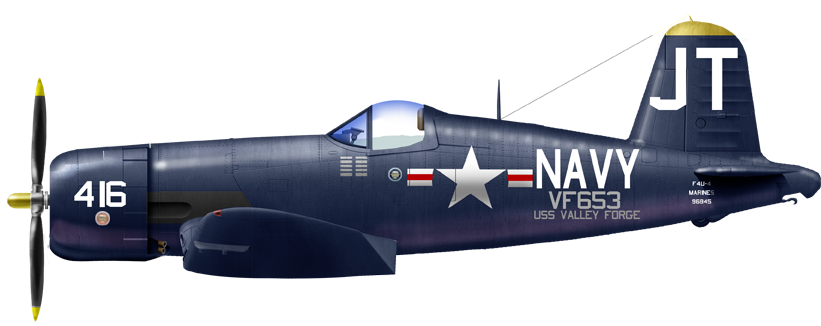
F4U-4 “Korean war Hero” USS Valley Forge 1950
The “whistling death” and its gullwings had a bad start due to its design, ill-suited for carrier landings, and soldiered on instead with the USMC from island airfields. In 1944 however its other user, the FAA, found ways to make it land safely, and this method was passed on to the USN, which started to field the Corsair from its carriers in 1945. At V-Day it was seen as the best fighter bomber of the USN and went on surprisingly long in service, taking part in the Korean war from 1950 to its conclusion in 1953, mainly from Essex class carriers.
F8F Bearcat
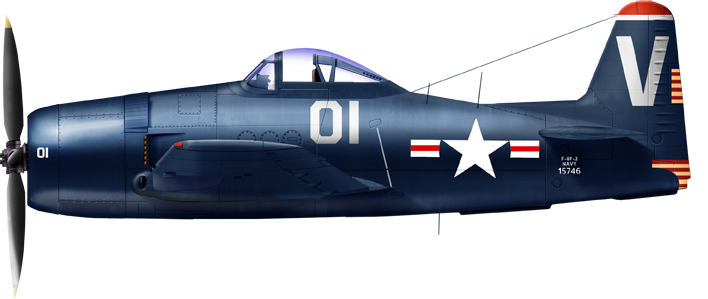
F8F-2 CVG-11 USS Valley Forge, 1949
The Grumman F8F Bearcat was the last classic single-engine carrier-based piston-powered fighter of the company, designated successor of the F6F Hellcat. It first flew on August 21, 1944 powered by a Pratt & Whitney R-2800 Double Wasp at 455 mph and weighted 7,070 lb. This was an interceptor that could be used as attack aircraft, albeit in this role the Corsair was preferred. It also could reach 1,105 miles range. Operational squadrons equipped with Bearcats started to replace the Hellcats from May until the end of 1945 and through 1946. It was deployed until 1955 and then replaced by jets and/or passed on to the USMC (1,265 made). It fought over Korea on all Essex carriers deployed, praised by all pilots for its capacity to be on par with early jets.
F7F Tigercat
The Grumman F7F Tigercat was the first twin-engine fighter in service with the US Navy, initially designed for the new Midway-class and too large to operate on earlier-class carriers such as the Essex class. It was nevertheless tested but never fielded in squadrons. The Tigercat first flew in November 2, 1943 and in production was powered by two Pratt & Whitney R-2800 Double Wasp to 435 mph and could reach 1,181 mi at 222 mph.
AD Skyraider
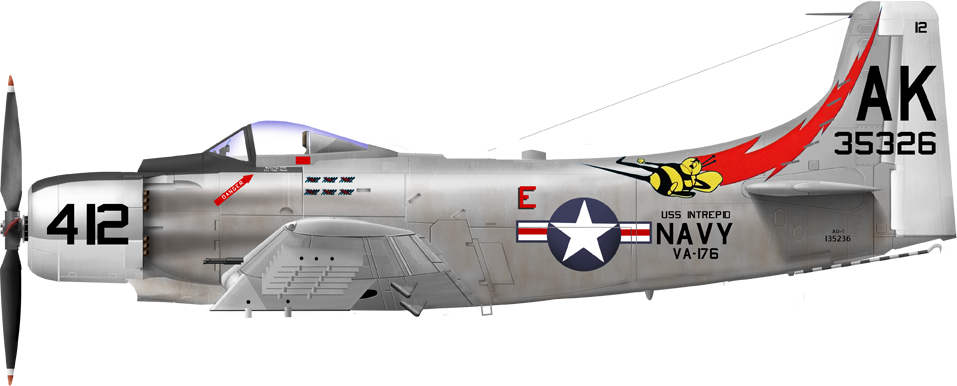
A-1H from VA-176 USS Intrepid, 1966
The Douglas AD Skyraider was designed initially as single seat piston-engine attack/torpedo aircraft, until the second task was seen obsolete. As a pure attack aircraft it proved extremely resilient and capable of carrying an enormous payload and stay long over the field unlike fighters. It soldiered over Korea and over Vietnam until the very end, particularly capable against the Ho Chi Minh trail and to cover SAR missions to retreive downed pilots in enemy territory.
TBM-3S/W Avenger
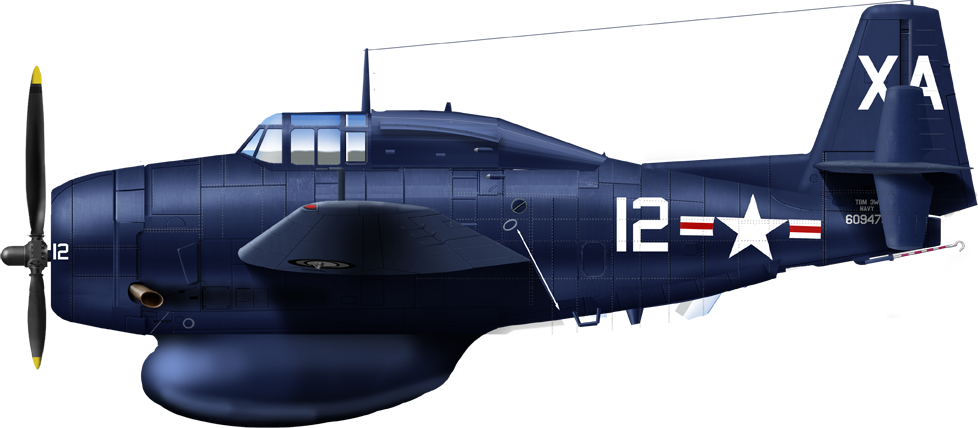
In the early days of dedicated ASW squadrons, the Grumman TBM (General Motors version) S was the striker, and the TBM 3W was the spotter. The latter was fitted with a recoignisable AN/APS-20 radar radome underbelly, and also worked as airborne early warning control and relay platform.
Grumman AF Guardian
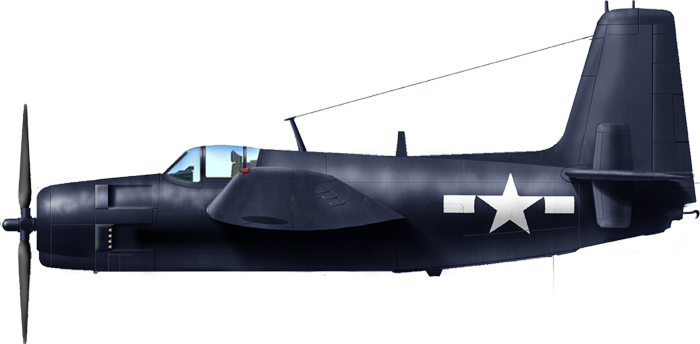
The Grumman AF Guardian was the first carrier-based anti-submarine warfare aircraft to enter service with the United States Navy. Fewer than 400 units were built and used in active service from 1950 to 1955. First flight: December 19, 1945. Range 1,501 mi, top speed: 317 mph, Mass: 14580 lb.
Grumman S2F Tracker
![]()
The Grumman S-2 Tracker (S2F before 1962) as a dedicarted piston-engine powered ASW aircraft with a high folding wing that and tricycle undercarriage, also well exported. It arrived in 1952 and some variants soldiered on in the mid-1980s or even 2000s with Argentina and Brazil. 1,284 were made. It only could reach 243 kn (280 mph, 450 km/h) at sea level but had 9h autonomy and was capable of carrying 4,800 lb (2,200 kg) of payload in its bomb bay and 6 under-wing hardpoints with five types of Torpedoes, Mk.54 Depth charges and naval mines as well as booys. It was seconded, partially replaced by the S-3 Viking (which was too heavy to enter service on the Essex).
Jets:
F2H Banshee
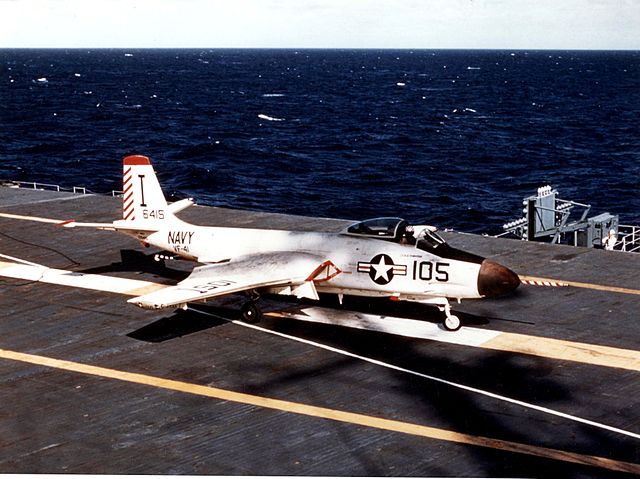
The McDonnell F2H-1 Banshee was a single-seat, twin-jet fighter from McDonnell used during the Korean War. It first flew on January 11, 1947, reached 586 mph in speed and had a ferry range of 1,200 miles, developed from the McDonnell FH-1 Phantom.
F9F Panther

F9F-2 Panther in September 1953 (attack on Tokori, Korea), USS Oriskany.
The F9F Panther was designed in the late 1940s to succeed to the F8F bearcat for aircraft carriers, with a modern fuselage and straight wings, which first flew by November 21, 1947. it entered service in 1952 and took part in the Korean war. It was capable of 579 mph and 1,353 miles range or 1,689 km.
F9F Cougar

F9F-8 Cougar from VF-32 USS Ticonderoga, Mediterranean 1955.
Albeit looking similar, the F9F Cougar was a derivative of the Panther with swept wings. It first flew on September 20, 1951, entered service in 1953. Top speed was 647 mph and climb speed Ascent speed 1,272 m/mi. it missed the Korean war but stayed in service until the 1980s in specialized roles.
F6U Pirate
The Vought F6U Pirate was Vought’s entry into the jet bandwagon, to replace the legendary Corsair. It used a of turbojet and first flew in 1946, becoming the first USN jet naval fighter with afterburner and using composite material construction. But it was a dog, woefully underpowered so much it became unsuitable for combat and was ever issued to operational squadrons, being used for training and withdrawn in 1950. Some were likely tested on Essex class carriers before cancelled.
F3D Skyknight

The Douglas F3D Skyknight was a twin-engined side by side seats Douglas night fighter which first flew on 23 March 1948. It was not supremely agile or fast, and 265 were made, soldiering until 1970, notably during the Vietnam War. It was a dedicated radar-equipped carrier-based night fighter and soon proved instrumental in filling a distinctive capability until declared obsolete and versed to other roles.
FJ Fury
 The North American FJ-2 and FJ-3 Fury were carrier-based swept-wing fighters designed by North American Aviation and basically a navalized version of the excellent F-86 Saber or Korean war fame. It first flew in 1951 and 741 were made, introduced in 1954, in service until 1960 and developed into the FJ-4 Fury. it was capable of 680 mph but was a dogfighter, not created to carry missiles.
The North American FJ-2 and FJ-3 Fury were carrier-based swept-wing fighters designed by North American Aviation and basically a navalized version of the excellent F-86 Saber or Korean war fame. It first flew in 1951 and 741 were made, introduced in 1954, in service until 1960 and developed into the FJ-4 Fury. it was capable of 680 mph but was a dogfighter, not created to carry missiles.
The FJ-4 Fury featured an entirely new wing design and very different than the original, with performances to match. it first flew in 1954, and 374 were made. Not suited to carry missiles it still patrolled with 4 × AIM-9 Sidewinder missiles but was preferred for ground attacks flying at 680 mph up to 2,020 mi. It was retired in 1964, much later than the original F-86.
F7U Cutlass
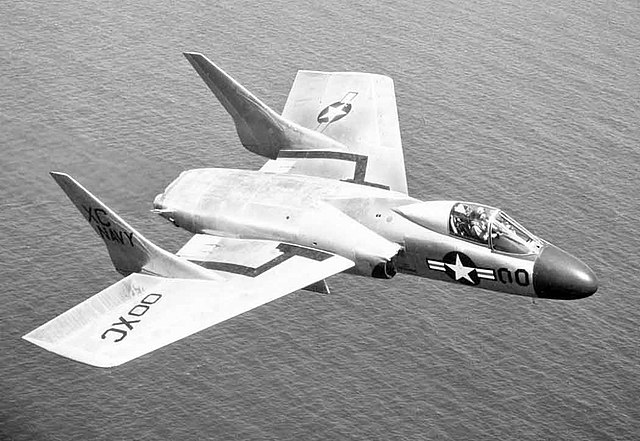
Another attempt of Vought in the Jet bandwagon, the F7U Cutlass was a futuristic looking twin boom carrier-based fighter which first flew in 1948 and was introduced in 1951 after many issues were cured. It was the first with an afterburner and a radar for air-to-air missiles plus arrowed wings, capable of 680 mph. But with a Mass of 18,210 lb it was tricky to fly and never popular on the “small” Essex class (compared to supercarriers). 320 were made, but retired in 1959 due to its high accident rate.
AJ Savage
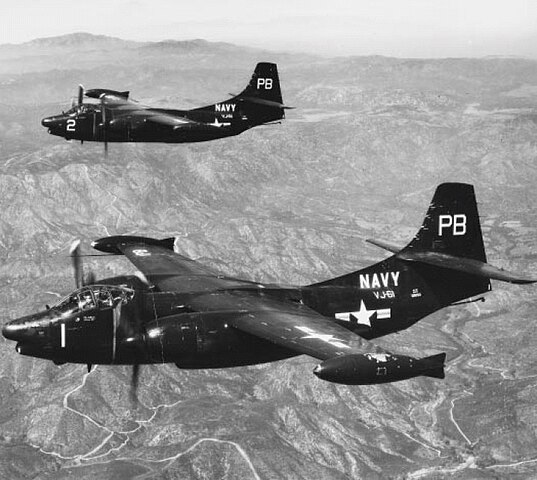
The North American AJ Savage was a twin-prop carrier-based bomber which contract was awarded in June 1946, and first flew on July 3, 1948, in servive service in 1949. It was to be an alternative to the P-6 Neptune for the Navy deterrence programme until it was curtailed. The Savage was powered by two Pratt & Whitney R-2800 Double Wasp coupled with an Allison J33-A-10 turbojet fitted in the rear fuselage to help take offs with the full load. It was 63 ft long, weighted 27,560 lb and was capable of 470 mph or a range of 1,629 miles, one of the largest aircraft ever put to an Essex class carrier.
F3H Demon
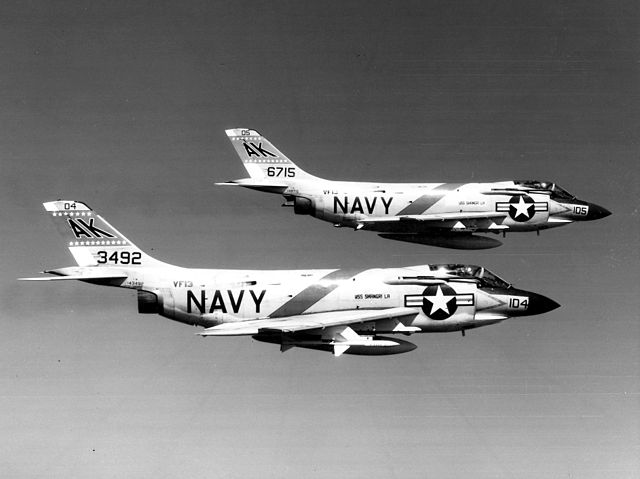
The McDonnell F3H Demon was a subsonic swept-wing carrier-based jet fighter from McDonnell, first swept wing jet fighter developed during the late 1940s/early 1950s to succeed the F2H Banshee, which first flew on 7 August 1951 intended to deal with the MiG-15 over Korea but it was burdened by 7,000 lb (3,200 kg) extra weight impacting performances. Enteriring service in 7 March 1956, it eventually complemented the F8U Crusader and F11F Tiger as a missile-armed interceptor, withdrawn in 1964. It saw action on several Essex class carriers, notably with VF-13 (photos) on Bennington, Essex and Shangri-La.
F4D Skyray

The Douglas F4D Skyray (later F-6 Skyray) was a carrier-based supersonic fighter/interceptor from Douglas and first naval fighter to exceed MACH 1 in level flight and last Douglas fighter before the merger with McDonnell,starting 1949 as D-571-1 design study. This delta wing intercept was selected in 1948 with the Westinghouse J40 turbojet engine but produtction was delayed until June 1954. She started service by April 1956 but had a brief service life and saw no action. She achieved 752.943 mph (1,211.744 km/h) still as a time-to-altitude record at 49,221 feet (15,003 m) in 2 min. 36 seconds at 70° pitch angle. The Skyray left service in February 1964.
F11F Tiger
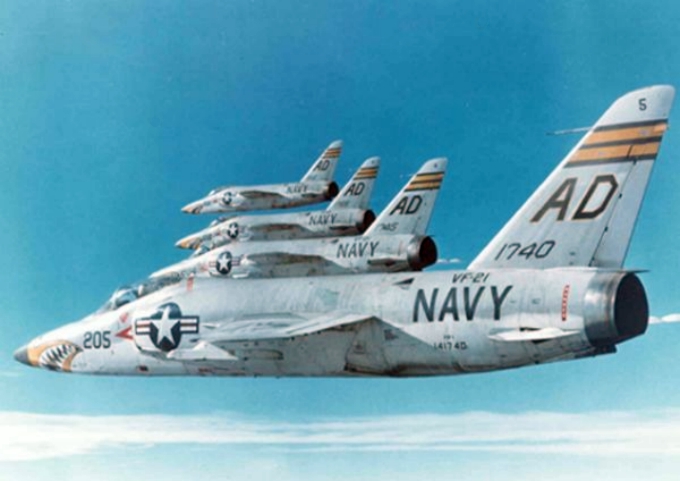
The Grumman F11F/F-11 Tiger was a supersonic, single-seat carrier-based fighter from Grumman which once set an altitude record of 76,939 feet (23,451 m). Work commenced in 1952 a G-98, to improve the F9F-6/7 Cougar but the XF9F-8 which flew on 30 July 1954, was very different and achieved Mach 1. 199 were produced, etering service in 1956, flown from Intrepid, Lexington, Hancock, Bon Homme Richard, Shangri-La, Forrestal, Saratoga and Ranger. Inferior to the Vought F-8 Crusader and with a somewhat unreliable engine it was replaced by the F-4 Phantom II, last withdrawn in 1969.
F8U Crusader

F8E Crusader USMC, VMF(AW)212 Lancer USS Oriskany, CVW-16 Gulf of Tonkin 1965
The F-8 Crusader is a supersonic interceptor built by Vought for aircraft carriers, characterized by a frontal air inlet and a wing with variable pitch angle. Pratt & Whitney J57, Top speed: 1,227 mph. 54 ft x 36 ft, first flight March 25, 1955.
A4 Skyhawk
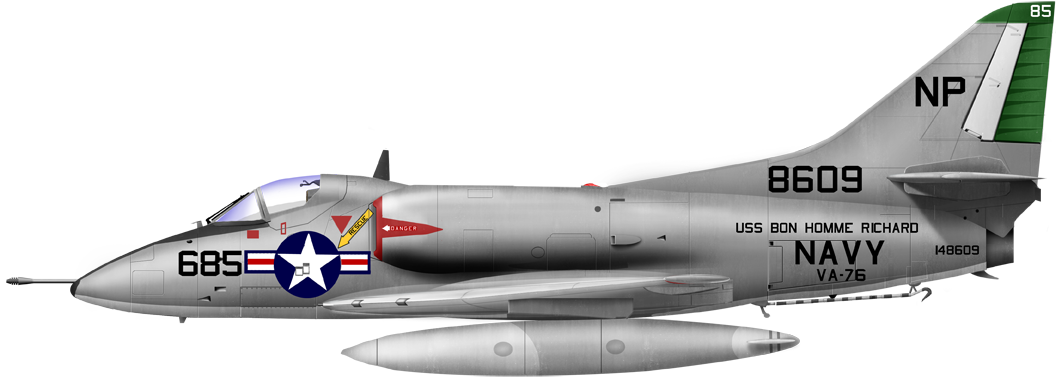
A4C Skyhawk from VA-76, USS Bon Homme Richard 1965.
The A4 Skyhawk (first flight June 22, 1954) was the planned replacement for the AD Skyraider by the same company. The first proved difficult to replace while the second was a small bird that found particularly at ease on smaller decks and only jet to operate on the Essex classes and ex-British light carriers internationally. Robust, efficient and inexpensive, it has enjoyed significant commercial success with nearly 3,000 units built for around ten user countries at a Unit cost of c860,000 dollars. It modest top speed was 673 mph, powered by a Pratt & Whitney J52, Wright J65 with a length of just 40 ft, 700 mi range. The last were used until the 1990s at Top Guns as aggressors and Brazil retained theirs until the 2010s.
AJ Skywarrior
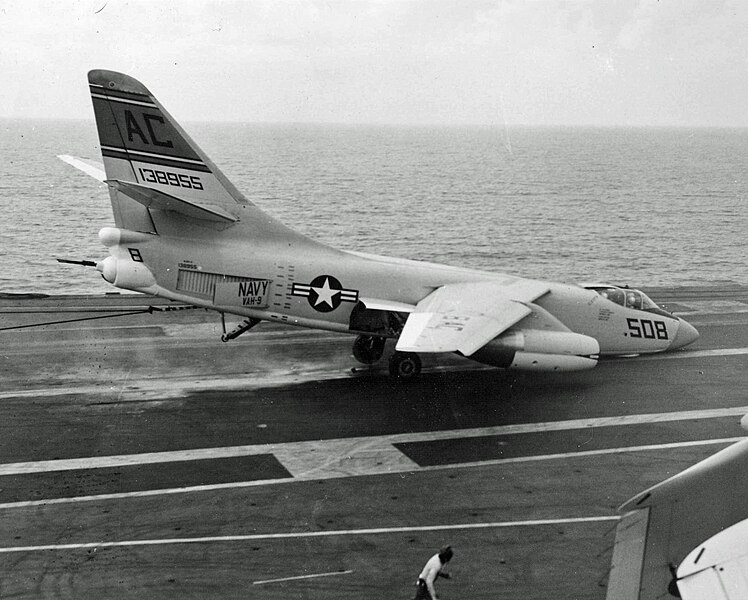
A3D collapsing its forward landing gear after landing on USS Saratoga.
The Douglas A-3 Skywarrior was a jet-powered strategic bomber from Douglas and largest carrier-base model as a carrier-capable strategic bomber. Development started by July 1949 based on the initial contract vs. eight other submissions. It was indeed developed for a 68,000 lb (31,000 kg) take-off weight at first intended for the Midway-class carriers. Unreliable until equipped with the Pratt & Whitney J57 by mid-1953 it first flew on 28 October 1952 and entered service by March 1956 and became an electronic warfare platform, tactical reconnaissance and airborne tanker as the Naval air nuclear program collapsed with the advent of Ballsitic missiles. It was found reliable and only retired in 1991 as the heaviest operational aircraft on any aircraft carrier, even the Vigilante. It also served on most modified Essex class carriers unlike the latter.
Vought A7 Corsair II
![]()
The top of the line Essexes air groups of the late-Vietnam era had A7 Corsair II and Douglas Skyhwak and Skyraiders, Vought F8U Crusaders interceptors and Grumman S2 Tracker ASW hunters. Here, CVW-19 group aboard USS Ticonderoga in 1970.
The Ling-Temco-Vought A-7 Corsair II was a carrier-based attack aircraft from the mid-1960s, derived from the F-8 Crusader which became the new main USN attack aicraft for decades, well beyond the cold war (first flight September 26, 1965). It had a Turbojet to reach 1,110 km/h and cost was USD 2,860,000. It could carry up to 15,000 lb (6,800 kg) of military hardware. It soldiered from Vietnam to the gulf war, including from Essex class ships. In 1970, the three A-4 squadrons were replaced by two squadrons of A-7A Corsair IIs. The F-4 Phantom II and A-6 Intruder were considered too heavy to operate from the Essex-class.
Helicopters:
HUK Huskee (1958)
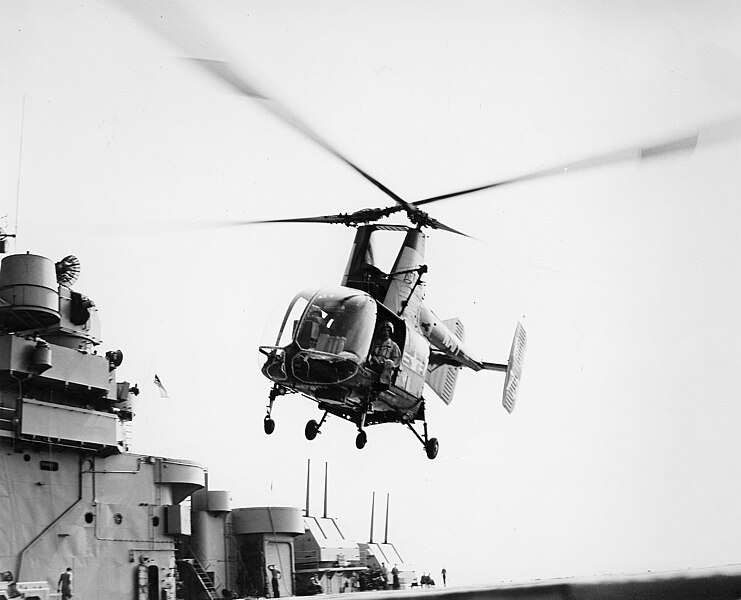
The Kaman HH-43 Huskie was distinctive for its twin intermeshing rotors, product of German aeronautical engineer Anton Flettner. It first flew on 21 April 1953, and entered production for the USAAF, USN and USMC. Thus was the main SAR model, extensively deployed during the Vietnam War. The HUK-1 became UH-43C. It was retired in the early 1970s.
HUP
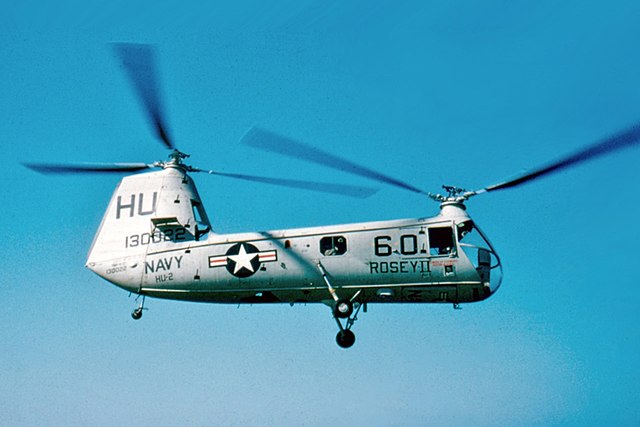
The Piasecki HUP Retriever was a compact single radial engine, with twin overlapping tandem rotor used as utility transport/SAR helicopter on Navy specification, and produced from 1949 to 1954, and first with an autopilot and to perform a loop. 339 were made, retired in 1964, replaced by the Sea King and Sea Stallion.
HO4S/HRS Chickasaw
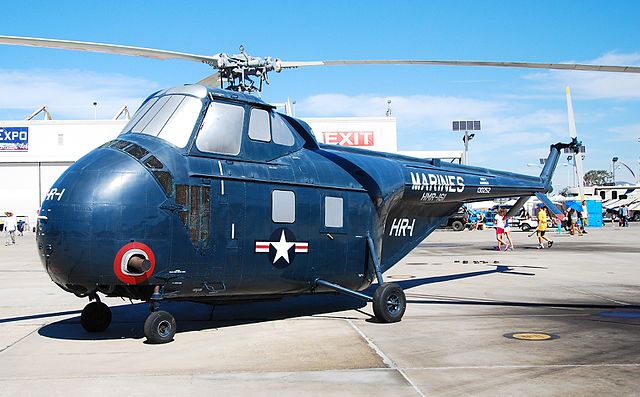
The Sikorsky H-19 Chickasaw was a multi-purpose piston-engined helicopter also license-built by Westland as the Whirlwind for the RN. It was called HO4S with the USB, HRS with the USMC. In 1962, it was called H-19. It was the first with a nose-mounted radial engine with a fully articulated main rotor directly above the cabin to maintain the center of gravity. 1,728 were made until 1960 (first flight 1949) and it was retired in 1969.
HSS Seabat
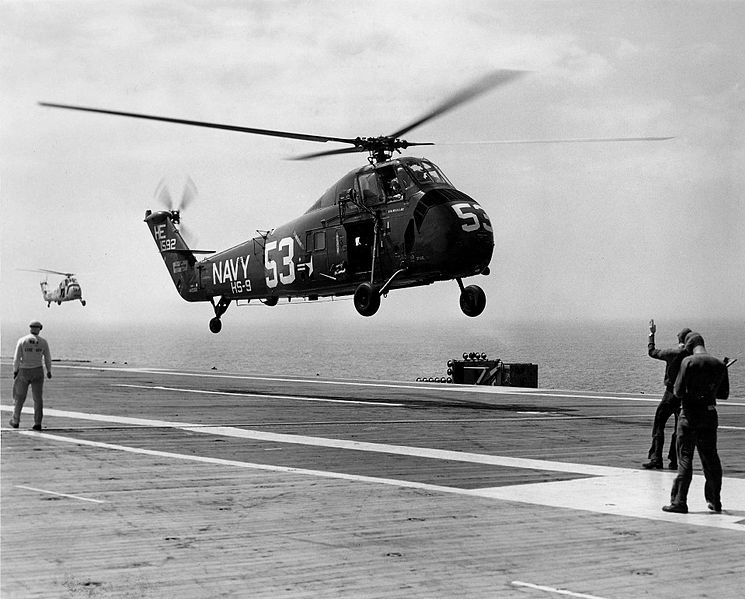
HSS-1 Seabat landing on USS Randolph in July 1959.
The Sikorsky H-34 was another piston-engined helicopter designed for ASW and was called either HUS Seahorse or HSS Seabat, also made under licence as the Westland Wessex using gas turbines. A total of 2,340 H-34s were manufactured between 1953 and 1970.
In 1973, close to retirement as training carrier at the end of the Vietnam war, USS Oriskany carried a modern air group comprising 24 F-8J Crusader interceptors, 36 A-7B Corsair II attack aircraft and four RF-8G Crusader for recce, four E-1B Tracer for ASW and three EKA-3B Skywarrior for Electronic warfare and surveillance, plus four SH-3G Sea King which acted as plane guard and for SAR.
An amazing carrer
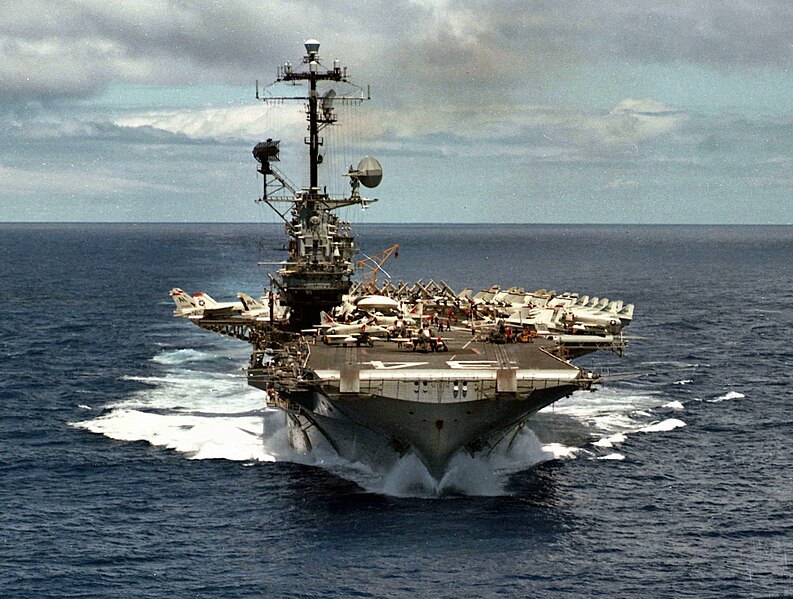
USS Oriskany en route to the West Pacific 23 June 1967
Despite their design was studied before WW2, they were completed late to take part in WW2 Pacific Operations to the fullest. Many were completed after hostilities ended. Nevertheless, they would not be scrapped, unlike thousands of small vessels, either motor torpedo boats, minesweepeers or escorts. Such large vessels were so valuable, even in a new geopolitical concept, that many survived until the 1970s, the 1980s and even, the late 1990s for the last ones (like USS Hornet). Three were turned into floating museums, unlike later Forrestal and Kitty Hawk vessels.
It’s easier to understand their career to explain it with a table:
CV-9 USS Essex (in service Dec. 1942): SCB-27A(1951), SCB-125(1956), SCB-144(1962 as CVS-9). June 1969 sold DRMS scrapped June 1975 Kearny.
CV-10 USS Yorktown (Jan 1943) SCB-27A(1953 as CVA-10), SCB-125(1955, CVS-10 1957), SCB-144(1966), Jun 1970 Museum Charleston.
CV-11 USS Intrepid (Apr 1943) SCB-27C(1954, CVA-11), SCB-125(1957), SCB-144(1965 CVS-11 from 1961). Decom. March 1974, Museum NYC 1982.
CV-12 USS Hornet (Aug 1943) SCB-27A(1953, CVA-12), SCB-125(1956, CVS-12 from 1958), SCB-144(1965), decom. Jun 1970, Museum Alameda 1998.
CV-13 USS Franklin (Oct 1943), reserve Feb. 1947, Sold, BU Aug 1966.
CV-14 USS Ticonderoga (Feb 1944) SCB-27C(1954, CVA-14), SCB-125(1957), CVS-14(1969), decom. Sep 1973, sold BU Sep. 1975
CV-15 USS Randolph (Jun 1944) SCB-27A(1953 CVA-15), SCB-125(1956, CVS-15 1959), SCB-144(1961), decom. Feb. 1969, Scrapped May 1975.
CV-16 USS Lexington (Feb 1943) SCB-27C/125(1955, CVA-16), CVS-16 1962, CVT-16 1969, AVT-16 1978, Nov 1991 Museum Corpus Christi, TX.
CV-17 USS Bunker Hill (May 1943), badly damaged, reserve Jan 1947. Sold for BU May 1973.
CV-18 USS Wasp (Nov 1943) SCB-27A(1951, CVA-18), SCB-125(1955, CVS-18 1956), SCB-144(1964). Decom. sold Jul 1972, scrapped May 1973.
CV-19 USS Hancoc (April 1944) SCB-27C(1954, CVA-19 1952), SCB-125(1956), CV-19, 1975. Jan 1976 Sold for BU.
CV-20 USS Bennington (Aug 1944) SCB-27A(1952 CVA-20), SCB-125(1955, CVS-20 1959), SCB-144(1963). Decom. Jan 1970 BU 1994 India.
CV-21 USS Boxer (Apr 1945) no upgrades, CVA-21 1952, CVS-21 1956, LPH-4 1959, decom. Dec 1969, scrapped Feb. 1971
CV-31 USS Bon Homme Richard (Nov 1944) SCB-27C/125(1955, CVA-31 1952) decom. Jul 1971, Sold for BU Mar 1992.
CV-32 USS Leyte (Apr 1946) CVA-32, 1952, CVS-32 1953, reserve May 1959 sold for BU Mar 1970.
CV-33 USS Kearsarge (Mar 1946) comp. Feb 1952 as CVA-33, SCB-27A(1952), SCB-125(1957, CVS-33 1958), SCB-144(1962), decom. Feb 1970, BU Feb 1974.
CV-34 USS Oriskany comp. Sep 1950 as SCB-27, CVA-34 1952, SCB-125A(1959), CV-34 1975. Decom. Sep 1976, reserve, scuttled reef Mex. May 2006.
CV-35 USS Reprisal (Dec 1945) uncompleted, scrapped Nov. 1949 by Boston Metals Co., Baltimore, Maryland.
CV-36 USS Antietam (Jan 1945) comp. Jan 1951 Exp. angled deck 1952 as CVA-36, CVS-36 1953, decom. May 1963 sold for BU Feb 1974.
CV-37 USS Princeton (Nov 1945) comp. Aug 1950 as Amphib CVA-37 1952, CVS-37, 1954, LPH-5 1959 decom. Jan 1970. BU 1971.
CV-38 USS Shangri-La (Sep 1944, comp. May 1951, CVA-38) SCB-27C/125(1955), CVS-38 1969 decom. Jul 1971, BU 1988 Taiwan.
CV-39 USS Lake Champlain (Jun 1945, comp. Sep 1952 as CVA-39, SCB-27A, CVS-39(1957) decom. May 1966, BU Apr 1972.
CV-40 USS Tarawa (Dec 1945, comp. Feb 1951 as CVA-40, CVS-40 1955, decom. May 1960, Sold oct 1968.
CV-45 USS Valley Forge (Nov 1946) Amphib CVA-45 1952, CVS-45, 1953, LPH-8 1961, decom. Jan 1970, sold Oct 1971.
CV-46 USS Iwo Jima (Jan 1945) under construction, Scrapped 1946 on slip, Newport News.
CV-47 USS Philippine Sea (May 1946) comp. as CVA-47, 1952, CVS-47, 1955, decom. Dec 1958, Sold Mar 1971.
Essex class in Korea:
Eleven of the Essex carriers participated in the Korean War. These ships played a major role throughout the entire war. Missions included attacks on all types of ground targets, air superiority, and antisubmarine patrols. The Korean War ensured 22 of the 24 Essex class carriers, nearly all mothballed in 1946-47, received more or less extensive service exception being surplus Bunker Hill and Franklin, which even fully repaired after receving heavy damage, were never recommissioned and kept in eternal reserve. They played a vital role in Korea, including unconverted carriers which still operated Corsairs and other piston models at ease. They generally split their work between strategic bombing (basically hammering all facilities and assets in North Korea) and close support for UN troops, which was equally vital, specially after the tables were turned over with the Chinese intervention in the winter of 1950. Carriers maintained CAPs (carre air patrols) but they were rarely involved in direct attacks by North Korean aircraft. Most were indeed vectored instead in interception of air raid over their own territory.
Carriers also provided SAR -Search and Recue- work which was invaluable to retreived downed airmen, both at sea and inland, whereas ASW patrols ensured no Soviet submarines came too close to sniff in US Carrier Battle Groups at work.
Essexes in the Cuban Crisis:
In 1962 the blockade ordered by President Kennedy over Cuba had the USN scrambled in the Carribean, a familiar deployment area in which several Essexes made tours. They were by that time no longer attack carriers but CVS, so rather ASW vessels, and yet still patrolled the skies around cuba reporting payloads on Soviet freighters, and in some cases, tracked down Soviet submarines, in some case rather agressively.
The Essex class which served in the Vietnam War:
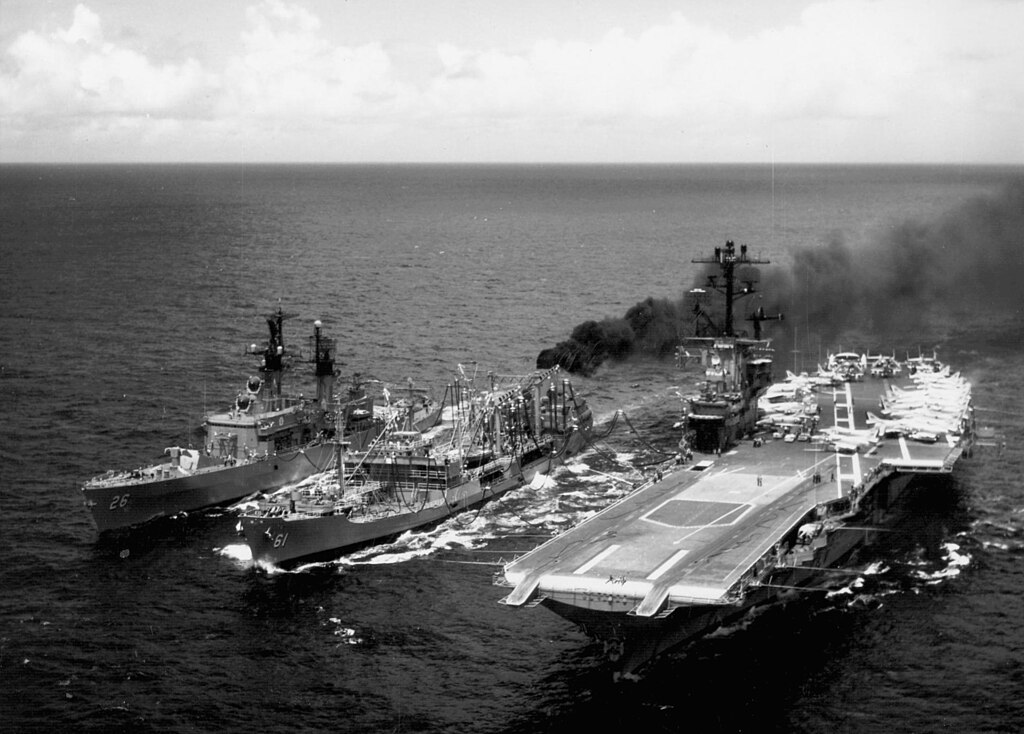
USS Intrepid (CVS-11) at Yankee Station, resplenished by USS Severn AO-61 USS Belknap (DLG-26) on 9 June 1968.
All carried attack air groups but by 1955 as jets were considered and supercarriers were on the way, still unconverted Essexes were given an “austere” conversion as anti-submarine warfare carrier (CVS), a designation established in August 1953. When the Forrestal-class entered srvice, eight 27A conversions became “CVS” and replaced the original unconverted ships, being far more capabke overall as the former left service in 1958-59. Two 27C conversions also became CVS in 1962 while still acting as attack carrier off Vietnam like Intreprid as well as two more in 1969. There were seven angle-deck, jet-capable 27As, one 27C which became FRAM II CVS with their bow-mounted SQS-23 sonar (SCB-144 program) in the 1960s, essentially the last upgrade they would ever receive. Thus allowed some to remain active until enough supercarriers arrived by the middle 1970s (notably the Nimitz class, essentially their deignated replacement). A revenant, USS Lexington served until 1991 as training ship, just like another WW2 vet, USS Midway.
-USS Yorktown: A 1964-1965 deployment with special operations in the South China Sea and ASW patrols, and air strikes inland. She concluded her tour of duty on 7 May 1965.
-USS Intrepid: April 1966-February 1969, three Vietnam deployments with Air Wing 10.
–USS Hornet covered the evacuation of Vietnamese from South Vietnam, during her late deployment with the 7th Fleet for operations on the South Vietnam coast.
–USS Ticonderoga was one of the most active in Vietnam. She made four peacetime deployments to the western Pacific from 1958, and launched more than 7,000 sorties in 1965-67.
–USS Hancock started her tour of duty in 1965, and she was deployed each year until 1975, gaining an impressive service record there.
–USS Bennington final seven years of active service included four assignments with the 7th Fleet in Vietnam from 1964 to 1868.
–USS Boxer (CV-21) was used as a transport during the war.
–USS Bonhomme Richard was for the anecdote a flagship, under command of Admiral George Stephen Morrison, father Jim Morrison, in the Gulf of Tonkin during the incident of August 1964 although the event rather involved the Ticonderoga. She made five Southeast Asia combat tours in six years, battling North Vietnamese MiGs on many occasions with CVW-21 and CVW-5 until her 1970 deployment, and she was decommissioned in July 1971.
–USS Kearsage: She started her first tour in July 1964 and returned in June 1966 until the end of the year.
-USS Oriskany: In April 1965 she joined for WestPac at Subic Bay, covering USMC landings to help the ARVN in north Vietnam. She deployed Air Wing 16, gaining a Unit Commendation for exceptionally meritorious service with 12,000 combat sorties. She returned in May 1966, and “Dixie Station” off South Vietnam, “Yankee Station” in the Gulf of Tonkin and 7,794 combat sorties, until a grave fire on 26 October 1966.
–USS Princeton: Started on October 1964, and transported there Marine Aircraft Group 36 in 1966. She served there with interruptions until 1968.
–USS Shangri-La: She was deployed with the second Fleet and Sixth Fleet assignments in 1965, but on 30 June 1969, she was redesignated an antisubmarine warfare carrier (CVS-38) and spent seven months launched combat sorties at Yankee Station in 1970.
–USS Valley Forge: On 2 August 1964, the Gulf of Tonkin started and Valley Forge was mobilized, carrying marines and aircraft in the South China Sea in late 1965. She participated in many operations until 1969 and was decommissioned shortly after.
-USS Philippine Sea was the only carrier never deployed in Vietnam.
See also Essex class in Vietnam
Cold War carrer
 USS Essex (CVA/CVS-9)
USS Essex (CVA/CVS-9)
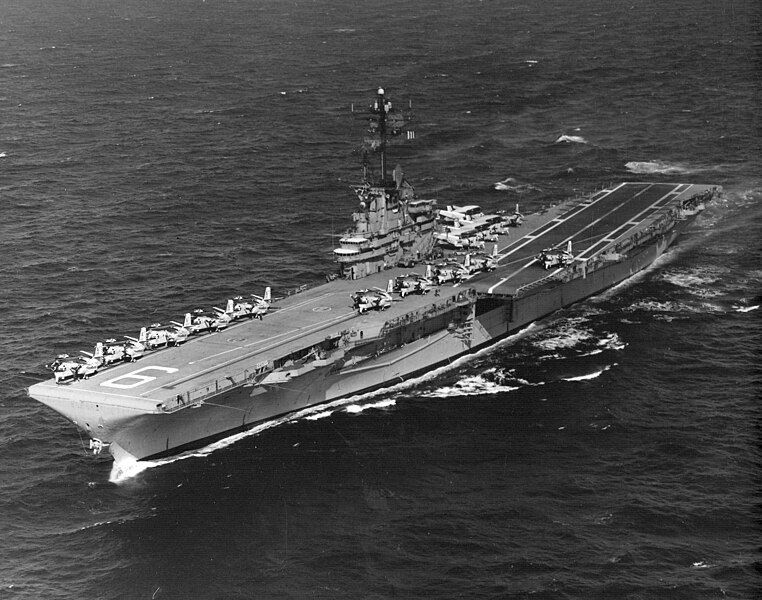
USS Essex in 1967 off Vietnam, her deck jam-packed with S-2 trackers, as she served as ASW carrier.
On 9 January 1947, she was decommissioned, reserve but modernized and recom. on 16 January 1951 (Captain A. W. Wheelock), with a shakedown cruise in Hawaiian waters, and she made three tours in Far Eastern waters as part of the Korean War. She was the flagship for Carrier Division 1, TF 77. She was the first to launch launch F2H Banshees in combat. On 16 September 1951 of of these crashed into aircraft parked on her forward flight deck (7 killed) and she was repaired at Yokosuka, back on 3 October, offensive on Yalu River with more deployment from August 1951 to March 1952 and from July 1952 to January 1953. On 1 December 1953 she made her last tour as the “Peace Patrol”.
Spring 1954 with USS Boxer she was redeployed to the South China Sea between Indochina and the Philippines and stayed on station is case she needed to support French troops in the Battle of Dien Bien Phu. From November 1954 to June 1955 she was in training exe with the 7th Fleet and assisted in the Tachen Islands evacuation.
In July 1955, she was modernized at Puget Sound (SCB-125) until March 1956. For 14 months she trained off the West Coast with a brief sortie to the 7th Fleet. She left San Diego on 21 June 1957 voa the Cape Horn to NAS Mayport on 1 August, Atlantic service.
She took part in ASW support in NATO Exercise Strikeback. February 1958 saw her first Med Tour with the 6th Fleet until May and Middle East crisis on 14 July 1958, US landings in Beirut. She crossed the Suez Canal to Taiwan with TF 77 and back to Mayport. She trained with the 2nd Fleet and RN/NATO forces atlantic and eastern Mediterranean until ate 1959. December saw her for huma. relief after a flood at Fréjus, France. Spring of 1960: She was converted as ASW Support Carrier, NAS Quonset Point (Rhode Island), flagship CarDiv 18, ASW Carrier Group 3. She rescued crews from a downed blimp, made a cruise with midshipmen and took part in NATO-CENTO exercises via the Suez Canal and Indian Ocean (Karachi, Aden) and with the French navy in Operation Jet Stream. On 7 November 1960 she shadowed the research vessel Vityaz in the Arabian Sea via S-2F Tracker.
 Next she took part in the Bay of Pigs and Cuban Missile Crisis from April 1961, and obtained 12 A4D Skyhawks from VA-34 from Florida armed for clandestine ground support with markings crudely obscured with flat gray paint. They provided air support to CIA-sponsored bombers in the Bay of Pigs Invasion. Ultimately this was aborted by President John F. Kennedy and the entire VA-34 crew was sworn to secrecy but was awarded the Navy and Marine Expeditionary medals.
Next she took part in the Bay of Pigs and Cuban Missile Crisis from April 1961, and obtained 12 A4D Skyhawks from VA-34 from Florida armed for clandestine ground support with markings crudely obscured with flat gray paint. They provided air support to CIA-sponsored bombers in the Bay of Pigs Invasion. Ultimately this was aborted by President John F. Kennedy and the entire VA-34 crew was sworn to secrecy but was awarded the Navy and Marine Expeditionary medals.
Essex next cruised to Northern Europe (Rotterdam, Hamburg, Greenock) and was toured each time by visitors. She ran aground in the Elbe River. and when returning, went into a severe north Atlantic storm by January 1962, with major structural damage. Early 1962 saw her repaired in dry dock and overhauled at Brooklyn Navy Yard. She was in sea trials when Kennedy ordered a naval “quarantine” on Cuba from October 1962 and she spent a month in the Caribbean as part of the blockade.
On 10 November 1966 while in RAS, she collided with USS Nautilus which sustained extensive sail damage. Essex hull was repaired at Boston Naval Shipyard with an overhaul. By 25 May 1968, she was flew over in the Norwegian Sea by an agressive Tu-16 heavy bomber which on the fourth pass, clipped the surface and disintegrated, so she launched rescue helicopters and retrieved 3 bodies, later transferred to a Russian destroyer via life boat.
Essex was mobilized for the Apollo 1 space mission which failed on 27 January 1967 but she did part in the Apollo 7 mission, recovering the crew on 22 October 1968. Future Apollo 11 astronaut Neil Armstrong served on board in the Korean War. She was decommissioned on 30 June 1969 at Boston Navy Yard, stricken 1 June 1973, sold to DRMS for scrapping on 1 June 1975.
 USS Yorktown (CVA-10, CVS-10)
USS Yorktown (CVA-10, CVS-10)
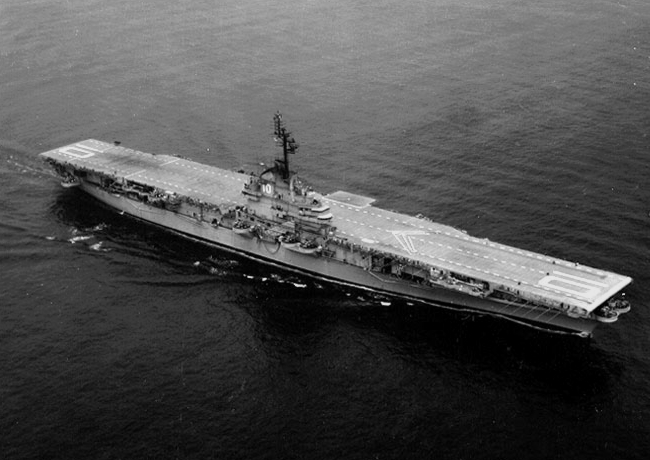
After several runs as part of Operation Magic carpt, USS Yorktown was decommisisoned on 9 January 1947, berthed in the Bremerton Group, Pacific Reserve Fleet but reactivated by June 1952, and modernized at Puget Sound until 15 December 1952, then 1953, recom. on 20 February 1953 under Captain William M. Nation. After training in the summer of 1953 she departed for Korea on 3 August, via Pearl Harbor (until 27 August) and arrived on 5 September in Yokosuka, then on 11 September joined TF 77 in the Sea of Japan, but the armistice was signed two months earlier so she trained and served until 18 February 1954, went to Yokosuka for R&R and sailed home via Pearl Harbor to NAS Alameda (3 March).
After a short overhaul at Hunters Point Naval Shipyard she saw a documentary film on her deck “Jet Carrier”. Routine operations along the west coast went on and in July she sailed to Manila, operated in Subic Bay area for the 7th Fleet, stopping at Yokosuka and Hong Kong. By January 1955, she helped the evacuation of Nationalist Chinese from the Tachen Islands. She sailed for home on 18 February.
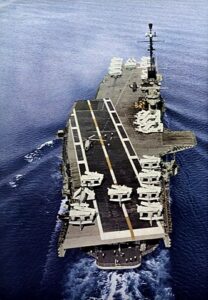 On 21 March 1955 she was in reserve for a new refit until 14 October, training off the West Coast until mid-March 1956 and started her 3rd TOD with the 7th Fleet via Pearl Harbor and Yokosuka and for five months between the Sea of Japan, East and South China Sea. She was back at Alameda on 13 September, followed by west coast operations and departed for her 4th WestPack on 13 November and 9 March 1957 via Oahu and Guam, three months with TF 77 and back home on 25 August. Shje was homeported to Long Beach, California and became an ASW carrier (CVS-10) modified at Puget Sound until February 1958. For 8 months she was in operations along the west coast adn departed for a WestPac on 1 November via Pearl Harbor (8–17 November) reaching Yokosuka on 25 November. She earned later three Expeditionary Medal answering the PLA shelling of Nationalist held Quemoy and Matsu. She was seen off Vietnam during internal disorders and was back at San Diego on 21 May. After ops along the west coast, by January 1960 she made another WestPac, earning more Armed Forces Expeditionary medals in Vietnamese waters and later started a 4-month overhaul ate Puget Sound until January 1961. She made another Vietnam ToD from 29 July with anti-air and ASW exercises, port visits and back at Long Beach on 2 March 1962 then west coast operations. In her late 1962 deployment she served as flagship, CarDiv 19 taking part in SEATO Operation Sea Serpent and departed on until 6 June 1963. Se hada maintenance at Long Beach Naval Shipyard and by 22 October 1964 joined the 7th Fleet again.
On 21 March 1955 she was in reserve for a new refit until 14 October, training off the West Coast until mid-March 1956 and started her 3rd TOD with the 7th Fleet via Pearl Harbor and Yokosuka and for five months between the Sea of Japan, East and South China Sea. She was back at Alameda on 13 September, followed by west coast operations and departed for her 4th WestPack on 13 November and 9 March 1957 via Oahu and Guam, three months with TF 77 and back home on 25 August. Shje was homeported to Long Beach, California and became an ASW carrier (CVS-10) modified at Puget Sound until February 1958. For 8 months she was in operations along the west coast adn departed for a WestPac on 1 November via Pearl Harbor (8–17 November) reaching Yokosuka on 25 November. She earned later three Expeditionary Medal answering the PLA shelling of Nationalist held Quemoy and Matsu. She was seen off Vietnam during internal disorders and was back at San Diego on 21 May. After ops along the west coast, by January 1960 she made another WestPac, earning more Armed Forces Expeditionary medals in Vietnamese waters and later started a 4-month overhaul ate Puget Sound until January 1961. She made another Vietnam ToD from 29 July with anti-air and ASW exercises, port visits and back at Long Beach on 2 March 1962 then west coast operations. In her late 1962 deployment she served as flagship, CarDiv 19 taking part in SEATO Operation Sea Serpent and departed on until 6 June 1963. Se hada maintenance at Long Beach Naval Shipyard and by 22 October 1964 joined the 7th Fleet again.
She made her first ToD in Vietnam for combat missions in 1964 and 1965 with special operations in the South China Sea, ASW services for the fast carriers conducting air strikes, until 7 May 1965.
She started her 2nd Vietnam ToD from 5 January 1966 with TF 77 on Yankee Station and taking part in SEATO exercise Operation Sea Imp. She was back at San Diego on 27 July. From 24 February 1967, she saw a 7-month overhaul. She made her last Vietnam ToD from January 1968 in the Sea of Japan for ASW and SAR support for Task Force 71 assembled after the North Korean capture of USS Pueblo, Operation Formation Star. After a stop at Subic Bay she made three tours of duty with TF 77 on Yankee Station. Back at Long Beach on 5 July she was overhauled in the Naval Shipyard for 3 months. By December she wa sused for the movie, Tora! Tora! Tora!. By December 1968 she was a recovery vessel Apollo 8 bewteen Pearl Harbor and Long Beach, Atlantic and South America. She took part in Operation Peacekeeper and visited northern European ports (Brest, Rotterdam) and resumed hunter/killer ASW exercises, stopping in Kiel, Copenhagen, Portsmouth and back at NS Norfolk by 11 December. In 1970 USS Yorktown was prepared for inactivation, decom. on 27 June at Philadelphia, berthed with the Philadelphia Group (Atlantic Reserve Fleet), stricken 1 June 1973 but later donated to the Patriot’s Point Development in Charleston, towed there in June 1975 and later converted as a memorial and museum, still here today.
 USS Intrepid (19)
USS Intrepid (19)
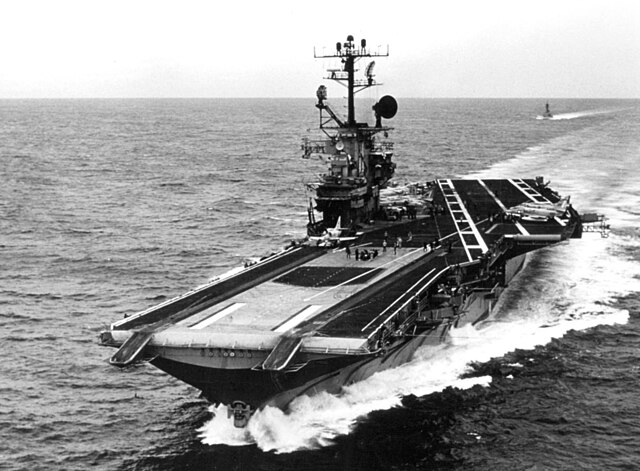
On 4 February 1946, USS Intrepid was back from the pacific in San Francisco Bay, placed under “commission in reserve” from 15 August, decommissioned on 22 March 1947, Pacific Reserve Fleet until recommissioned on 9 February 1952 and sent to Norfolk NyD for her SCB-27C modernization as CVA-11 and the first to launch aircraft with her new steam catapults. She entered the Atantic fleet after recommission after a shakedown cruise in Cuba, HP Mayport in Florida, adn first ToD with the Mediterranean 6th Fleet, second on 5 September. From 29 September, she entered NyD for her SCB-125 modernization until April 1957, taking part in September to Operation Strikeback, largest peacetime naval exercise. In December she ws in Operation Crosswind (effects of wind on carrier launches) and from 1958 and 1961, she alternated Mediterranean and Atlantic deployments. She became CVS-11, on 8 December 1961 and started an overhaul on 10 March 1962 until, departing on 2 April with Carrier Antisubmarine Air Group 56 for training and later as recovery ship for Project Mercury off Puerto Rico. She had another refit after a midshipmen cruise from the summer of 1962 in Norfolk.
On 23 January 1963 she left Hampton Roads for ASW in the Caribbean and chased for the Venezuelan freighter Anzoátegui hijacked by pro-Castro mutineers until she surrendered at Rio de Janeiro. On 11 June 1964 she left Norfolk for Mediterranean hunter-killer training and shadowed a Soviet task group, earning a Battle Efficiency “E”. By September she carried 22 NATO statesmen touring U.S. military installations. She took part in Lord Cornwallis’s surrender celebrations with the French Ambassador.
On the night of 21 November airman Jenner Sanders fell overboard while driving an aircraft towing tractor but was rescued. Next she took part of Gemini 3 recovery on 23 March some 50 nmi (90 km) from her. Next she had a major overhaul at Brooklyn Navy Yard and her FRAM II (Fleet Rehabilitation and Modernization).
From April 1966 to February 1969 she made three tours of duty in Vietnam with CAW 10, notably deploying her 9e A-4 Skyhawks and 6 A-1 Skyraiders for ground attack missions. 7 months of service later she was back in Norfolk, Captain John W. Fair being awarded the Legion of Merit. She would earn three battles stars for her Vietnam campaign. On 9 October 1966 she lost a Skyraider from VA-176 downed by a MiG-17. While back home via the Suez canal in June 1967, she saw the Israeli–Arab crisis. The next year she won the Marjorie Sterrett Battleship Fund Award for the Atlantic Fleet. In her June 1968 – 8 February 1969 Vietnam tour she carried VF-111 Detachment 11 (F-8C), VA-106 (A-4E= VA-66 Waldos (A-4C), VFP-63-11 (RF-8G), VA-36 ‘Roadrunners’ (A-4C), VAQ-33-11 (EA-1F), VAW-121-11 (E-1B), and HC-2-11. t her return she was home ported at NAS Quonset Point, relieving USS Yorktown as flagship CarDiv 16. She was run aground without damaghe and took part in NATO exercises in April-October 1971 (visiting Lisbon, Plymouth, Kiel, Naples, Cannes, Barcelona, Hamburg, Copenhagen, Greenock, Rosyth, Portsmouth, Bergen) and tested operations beyond the Arctic Circle. After her lst refit in July 1972, she repated NATO exercises and swoop in thee Barents-Arctic Circle. She made a final cruise in the Mediterranean and by 15 March 1974, decommissioned. Next, she was preserved as museum ship after years in reserve.
 USS Hornet (CVA-12)
USS Hornet (CVA-12)
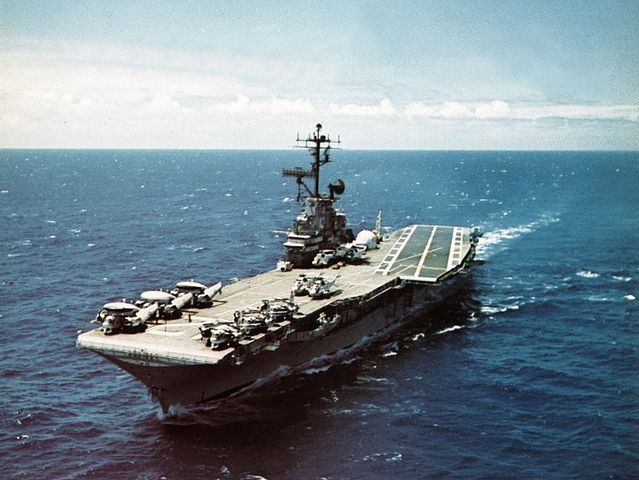
USS Hornet was decommissioned on 20 March 1951 and sailed San Francisco and New York Naval Shipyard, fully decommissioned on 12 May converted under SCB-27A upgrade program and whe her sister Wasp badly damaged her bow in a collision on 26 April 1952 it was cut away to repair Wasp so she was delayed and completed by 11 September 1953, recommissioned attack carrier. From HP Norfolk sha sailed on 11 May 1954 on a 8-month global cruise through the Mediterranean Sea, Indian Ocean, 7th Fleet in the South China Sea. She searched for Cathay Pacific Airways passenger plane shot down near Hainan Island. On 25 July she was in Philippine Sea, shooto,h down two attacking Chinese fighters until tensions eased and was back to San Francisco on 12 December. She made another ToD from 4 May 1955, helped evacuating Vietnamese and trained with the 7th Fleet, back home on 10 December, overhauled as Puget Sound for her SCB-125 upgrade.
She departed San Diego on 21 January 1957 for the 7th Fleet and mader another between 6 January and 2 July 1958 then had a conversion as ASW carrier at Puget Sound and on 3 April 1959, left HP Long Beach for ASW exercises from Japan to Okinawa, back in October.
At the time she carried a squadron of 20 Grumman S2F Trackers and HSS-1 Seabat ASW helicopters plus a few AD-5W Skyraider used as AEW aircraft and four McDonnell F2H Banshee fighters as close defence. After 1960 she had two sqiadrons of 10 Trackers each, one helicopter squadron (16 Seabats/ SH-3 Sea King); one AEW detachment (E-1 Tracers) but no fighters until 1965. Douglas A-4 Skyhawk were also carried.
She made several tours in Vietnam (earning xx battle stars) and took part in the Apollo program as a recovery ship. On 6 March 1965 one of her Sea King helicopter setup a record by flying from USS Hornet in San Diego to USS Franklin D. Roosevelt off Mayport without refueling over 2,106 miles (3,389 kilometers) in 16 hours and 52 minutes. Hornet sailed to Vietnam from October 1965 to January 1966 with the SCB-144/FRAM II upgrade bewteen the AN/SQS-23 sonar and CC improved displays. She was tasked of escort and SAR for the strike carriers, with few attack sories by her Skyhawks.
On 25 August 1966, she recovered the capsule of the second uncrewed flight Apollo. After a short maintenance home she was back on 27 March 1967 via Sasebo on 19 May and until October, then between November 1968 and April 1969.
She recovered the command module Columbia from Apollo 11 SW of Hawaii on 24 July 1969 with President Nixon on board and the three asotronauts in quarantine aboard Hornet prior to transfer. She would also recover Apollo 12 on 24 November off Samoa. She was was eventually decommissioned 26 June 1970, mothballed at Puget Sound, stricken on 25 July 1989. In 1991 she was preserved donated to the Aircraft Carrier Hornet Foundation on 26 May 1998, fully restored now as a museumship.
 USS Franklin (CVA 13, CVS-13)
USS Franklin (CVA 13, CVS-13)
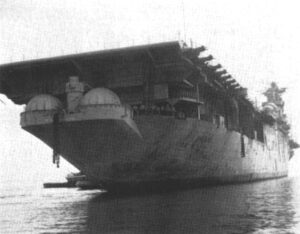 Franklin received 4 battle stars for her World War II service in which she was so badly damaged she nearly sank. After the war, she was opened to the public for Navy Day celebrations but on 17 February 1947, she was decommissioned at Bayonne in New Jersey (photo). Albeit redesignated as an attack aircraft (CVA-13) on 1 October 1952 and then ASW carrier CVS-13 on 8 August 1953, even the aircraft transport AVT-8 on 15 May 1959, modiications were never done after a spacialist team estemated their structure and hasty repairs in 1945 were not a good basis with all her sister still around. So she was stricken on 1 October 1964 with her sister Bunker Hill, ahso victim of severe damage and if the Navy envisiooned for many years an “ultimate reconfiguration” this was never done.
Franklin received 4 battle stars for her World War II service in which she was so badly damaged she nearly sank. After the war, she was opened to the public for Navy Day celebrations but on 17 February 1947, she was decommissioned at Bayonne in New Jersey (photo). Albeit redesignated as an attack aircraft (CVA-13) on 1 October 1952 and then ASW carrier CVS-13 on 8 August 1953, even the aircraft transport AVT-8 on 15 May 1959, modiications were never done after a spacialist team estemated their structure and hasty repairs in 1945 were not a good basis with all her sister still around. So she was stricken on 1 October 1964 with her sister Bunker Hill, ahso victim of severe damage and if the Navy envisiooned for many years an “ultimate reconfiguration” this was never done.
Her four turbo generators were saved before scrapping, when sold for scrap to the Portsmouth Salvage Company in Chesapeake on 27 July 1966.
 USS Ticonderoga (CVA-14, CVS-14)
USS Ticonderoga (CVA-14, CVS-14)
![]()
USS Ticongeroga left Tokyo to Bremerton Navy Yard, Puget Sound from 20 October 1945 with vets o, boards via Pearl Harbor, and made trips for Operation Magic Carpet. She was prepared in 1946 to inactivation in Bremerton decommissioned on 9 January 1947, Pacific Reserve Fleet and reactivated on 31 January 1952, sailed to New York on 27 February, decommissioned for her SCB-27C conversion and recom. on 11 September 1954, starting her sea trials under Capt. William A. “Bill” Schoech, homeported to Naval Station Norfolk, and after carrier qualifications with Air Group 6 she made a shakedown near Cuba
She took part in the International Air Show with her massive North American AJ-1 Savages from the Delaware and tested the A4D-1 Skyhawk, F4D-1 Skyray, F7U Cutlass, and F3H-2N Demon, then she was HP tp Mayport, sailed to Gibraltar, entered the Mediterranean for a 8 months ToD, back on 2 August 1956, and she underwent her SCB-125 upgrade completed by early 1957, the HP Alameda, California on 30 May, and departed on 16 September for her first 6 months WestPack and back to at Alameda on 25 April 1958. She made four peacetime deployments with the 7th Fleet with goodwill and liberty port calls but soon she took part in the Gulf of Tonkin incident.
On 2 August, while in these waters USS Maddox reported an attack from NVA FACs. Ticonderoga sent four, rocket-armed F-8E Crusaders, which strafed spotted NVA craft, destroying one, damaging two.
2 Days later she intervened for Turner Joy in air support and the crews claimed two boats sunk, two damaged. Pdt. LBJ ordered retaliatory air strikes on NVA torpedo boat bases. On 5 August, Ticonderoga and Constellation launched 60 sorties claiming 25 PT-type destroyed, bases ravaged, and rased oil storage depots. She would receive a Navy Unit Commendation.
After a trip to Japan in September for R&R she retruned to NAS North Island in California, on 15 December 1964. At Hunter’s Point NyS from 27 January 1965 she started her 5-month overhaul. She departed for another Vietnam ToD from 28 September at “Dixie Station” in 1965 and 1966 with 116 days in air operations between “Dixie” and “Yankee” off South and North Vietnam, delivering 8,000 short tons (7,300 t) of ordnance in 10,000 combat sorties, but loosing 16 aircraft, five pilots. Crews claimed 35 bridges and many other objectives. She was back in San Diego.
On 5 December 1965 she los an A-4 Skyhawk overboard off Kikai Island (Kagoshima) which carried a B43 nuclear bomb. The incident was covered up and only revealed in 1981.
On 15 October, she made another deployment via Pearl, Yokosuka, Subic Bay, and the Gulf for the 1966–1967 campaign, 11,650 combat sorties, with Air Wing 19 to Operation Rolling Thunder, and a second Navy Unit Commendation. Back in San Diego she had another refit, then in Puget Sound.
She departed on 28 December 1967 for her 1967-68 deployemnet on Yankee Station and was present during the Tet Offensive. With Operation Formation Star she relieved USS Ranger and was soon joined by USS Enterprise, plan to target 7 MiG airfields until it was cancelled. Back at Yankee, she made 120 days of combat duty, 13,000 combat sorties. Apart R&R at Subic Bay, NAS Cubi Point she also visited Singapore and Hong Kong. On 9 July, LCDR John B. Nichols claimed USS Ticonderoga’s first MiG kill. She wa slater back at NAS North Island in Coronado and had maintenance at Long Beach Naval Shipyard, prepared to operate the new A-7 Corsair attack jet.
She departed for her fifth combat Vietnam tour on February 1969. She stayed four months, but on 16 Aprilshe was ordered to the Sea of Japan as a North Korean fighter shot down a Navy reconnaissance aircraft there, but the crisis abated. After her 4th tour she joined TF 71 in the Sea of Japan, earning 3rd Navy Unit Commendation. She was back to San Diego on 18 September 1969. After Long Beach conversion as ASW aircraft carrier until 20 October (CVS-14) she was declared ready from 28 May 1970, homeported to San Diego and making a summer refresher training, air operations, landing qualifications, exercises-HUKASWEX 4–70, COMPUTEX 23–70. She also took part in the movie Tora! Tora! Tora! playing as USS Enterprise (CV-6).
She made two more deployments to the Far East, including Vietnam. She trained with the Japanese Maritime Self Defense Force and in the Indian Ocean with the Thai Navy as well as the eastern Pacific and and part of the recovery of Apollo 16 off Christmas Island in April 1972. After exercises in the Sea of Japan, American Samoa, recovering Apollo 17 and back to San Diego on 28 December. By June 1973, Ticonderoga she recovered Skylab 2 astronauts nearby. She stayed active for 9 more months, decom. on 1 September 1973, stricken on 16 November and sold for scrap on 1 September 1975.
 USS Randolph (CVA-15/CVS-15)
USS Randolph (CVA-15/CVS-15)
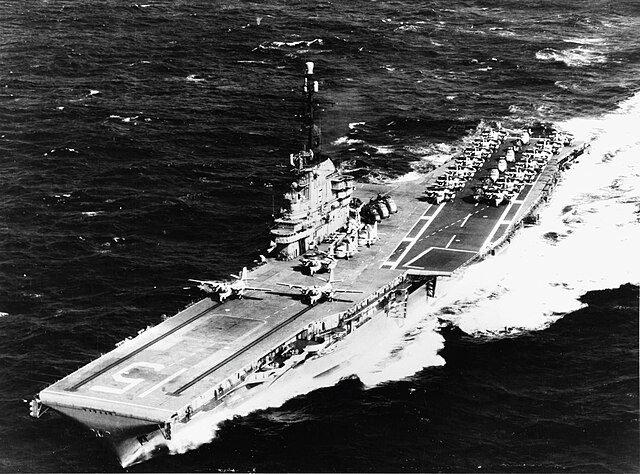
Back at Naval Station Norfolk on 15 October 1945 USS Randolph she was prepared for “Magic Carpet” and completed two trips to the Mediterranean. In 1946, she became a training ship for reservists and midshipmen, aldo cruising the Mediterranean and the Caribbean in the summer of 1947, decommissioned on 25 February 1948 at Philadelphia Naval Shipyard.
In June 1951 she underwent her SCB-27A modernization at Norfolk as CVA-15 on 1 October 1952, recommissioned on 1 July 1953. After shakedown off Ciba with CAG 10 and then CAG 14, she made her first Mediterranean tour with the 6th Fleet from 3 February 1954 for 6 months until 6 August. In Norfolk from 18 June 1955 she underwent her SCB-125 modernization and left on January 1956, for an East Coast six months trainign tour, seeing the first Atlantic Fleet carrier Regulus strategic cruise missile launch from her flight deck.
On 14 July 1956, she made a 7-month MED TOD with the 6th Fleet and stood ready during the Suez Crisis, her aircraft covering evacuation of U.S. nationals from Alexandria. She was back home on 19 February 1957 and was back in the med on 1 July 1957. She stayed off Syria during the coup and patrolled the eastern Mediterranean, back on 24 February 1958, then a 5th Med Tod from 2 September 1958 to 12 March 1959, reclassified CVS-15 on 31 March 1959, reequipped with S-2 trackers, and receiving a 4th consecutive Battle Efficiency “E” Award, in September 1960. From October 1960 to March 1961 she had the FRAM II or SCB-144 upgrade and by the summer of 1962 she was back to the Mediterranean but returned to the western Atlantic during the Cuban Missile Crisis in October-November. On 27 October she “caught” with 11 destroyers a the Foxtrot-class B-59 near Cuba, dropping practice depth charges on her to force her to the surface for identification. This narrowly avoid an attack by Valentin Grigorievitch Savitsky, which believing war haf just started, and had ordered to prepare a nuclear-tipped torpedo on Randolph under persuaded by Vasily Arkhipov.
Randolph had an overhaul at Norfolk, returned to the Atlantic and aletrnated for the next five years with Mediterranean deployments and northern European cruises. By July 1961 she as a recovery ship after Virgil “Gus” Grissom space flight and in February 1962, for John Glenn orbital voyage. On 1 April 1964 and third deck elevator tore loose in a night storm and fell into the Atlantic with a Grumman S-2D Tracker and crew on board, its tractor, but 3 crew were rescued by the destroyer USS Holder.
On 7 August 1968 she was announced to be decommissioned to reduce fiscal expenditures in 1969. She was decommissioned on 13 February 1969 at Boston, reserve fleet Philadelphia, stricken 1 June 1973, sold for BU on May 1975 at Kearny, New Jersey.
 USS Lexington (CVA-16/CVS-16/CVT-16/AVT-16)
USS Lexington (CVA-16/CVS-16/CVT-16/AVT-16)
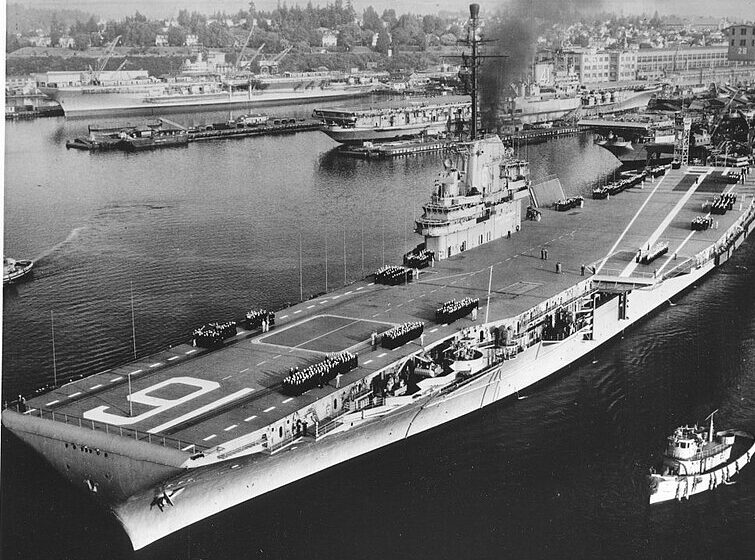
USS Lexington was decommissioned at Bremerton on 23 April 1947, Reserve Fleet, redesignated CVA-16 on 1 October 1952 and by September 1953 she entered Puget Sound for her SCB-27CA and SCB-125 conversions in a single refit, recommissioned on 15 August 1955 under Captain A. S. Heyward Jr.. She was homeported to San Diego and operated off California until May 1956 then a 6-month deployment with the 7th Fleet via Yokosuka and back to San Diego on 20 December. She trained Carrier Air Group (CAG) 12 and made another 7th Fleet deployment from June 1957, with Rear Admiral H. D. Riley, Commander CarDiv 1 back to San Diego on 17 October.
After another overhaul at Bremerton she was sent for the 2nd Taiwan Strait Crisis in July 1958 witth CAG 21 from San Francisco arriving on 7 August and back on 19 December. She was the first which aircraft received the AGM-12 Bullpup guided missiles and she sailed for another ToD on 26 April 1959, in standbay in the Laotian crisis (August-September) and back to San Diego on 2 December, then overhaul at Puget Sound.
She sailed for another WestPac late in 1960, 1961 and by January 1962 she was sent to relieve USS Antietam as aviation training carrier in the Gulf of Mexico. She became CVS-16 on 1 October 1962 and was on patrol during the Cuban Missile Crisis in between and relieved Antietam from 29 December 1962 at Pensacola. Missing logs here. In 1969, she operated from HP Pensacola, and Corpus Christi, training student aviators, with oncreased activity for USN/USMC pilots in the Vietnam war, making her 200,000th arrested landing on 17 October 1967 and redesignated CVT-16 on 1 January 1969, then AVT-16 on 1 July 1978, training for 22 more years until relieved by the supercarrier USS Forrestal, then decommissioned and struck on 8 November 1991. On 18 August 1980 she became the first carrier to have women on board. She had amajor landing accident on 29 October 1989, when a T-2 aircraft inverted commands and hit her island, killing 4, injuring 17. A major fire raged for 15 minutes. But preserved for more actovity, USS Lexington became the final Essex-class carrier in commission, and was preserved, ultimately she became a museum ship.
 USS Bunker Hill (CVA-17/CVS-17/AVT-17)
USS Bunker Hill (CVA-17/CVS-17/AVT-17)
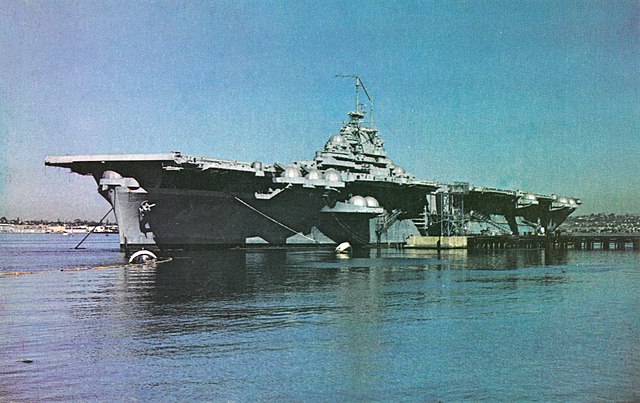
For memory, USS Bunker Hill was badly damaged by Kamikaze on 11 May 1945 off Okinawa. She acted a flagship for admiral Mitscher, and had 396 sailors and airmen killed, 43 missing, 264 wounded. 14 from Mitscher’s staff were also part of the casulaties. She could still sail after repairs by her own power to Pearl Harbor and reached Bremerton for more repairs, past V-Day. By 27 September she made her first tour of Operation Magic Carpet fleet with TG 16.12. She was opened to visitors on Navy Day 27 October 1945 in Seattle and by January 1946 she was ordered to Bremerton for deactivation, decommissioned 9 January 1947 and reclassified three times CVA-17 (October 1951), CVS-17 (August 1953), AVT-9 (May 1959) the latter being an “Auxiliary Aircraft Transport Carrier”. But inspected for damage the team estimated she was not worth the cost of modernization and she was declared surplus as well as her sister Franklin. Despote she had been fully repaired and in a like-new condition the “ultimate reconfiguration” never was acted, and she was stricken in November 1966, used as stationary electronics test platform at NAS North Island and on 2 July 1973 sold for scrap to Zidell Explorations, Inc. in Oregon. A sad end for a ship with 11 battle stars.
 USS Wasp (CVA/CVS-18)
USS Wasp (CVA/CVS-18)

Decorated by 8 battle stars, the carrier was mostly active in the Mediterranean during her 2nd career. After alterations, she took part in Operation Magic Carpet, to and from Italy. On 17 February 1946, Wasp ran aground off the coast of New Jersey. On 17 February 1947 she was decommissioned in the Atlantic Reserve Fleet. In the summer of 1948 she started a refit SBC-27A, recommissioned on 10 September 1951 and reporting to the Atlantic Fleet in November 1951, shakedown until February 1952, fixes at New York. On 26 April 1952, Wasp collided with USS Hobson during night flying operations underway to Gibraltar. Hobson lost 176 of her crew when sinking, and Wasp rescued 52 men. Her bow was torn and needed repairs at Bayonne, New Jersey, receving the bow of USS Hornet (CV-12) under conversion brought by barge from Brooklyn, fitted in 10 days. By 2 June 1952 she relieved USS Tarawa at Gibraltar and joined CarDiv 6 Mediterranean and she was relieved on 5 September by USS Leyte. She took part in NATO Mainbrace off Greenock and some R&R in Plymouth, the back to Norfolk in October. On 7 November she had a new overhaul in New York and preparations for a world cruise to the Pacific Fleet from 16 September 1953 (she took part in between to Exercise “Mariner”), entered the Mediterranean, passed the Suez Canal, crossed the Indian Ocean via Columbo, arrived in the Philippines, Japan and joined the TF 77. Durng her port visits she hosted Chiang Kai-shek and President Ramon Magsaysay (Philippines) hosted by Raymond A. Spruance. By April 1954, she was relieved by USS Boxer, sailed for San Diego HP.
She made her second ToD from September 1954 via Pearl Harbor and Iwo Jima, relieved Boxer in October 1954 and served with Carrier Task Group 70.2. and in 1955 joined TF77, being present in the evacuation of the Tachen Islands. On 9 February 1955 one of her AD-5W USN/VC-11 was shot down by the PLA. The crew was rescued by Nationalist Chinese patrol boats. Back to San Diego in April she had a 7 month overhaul at San Francisco. She left San Diego on 23 April with CAG 15 via Pearl Harbor and Guam, Japan in May, and TF 77 for Operation Sea Horse. She was later in the Philippine for the commissioning of the new naval air station making an air show for President Magsaysay and Admiral Arthur Radford. On 15 October she was reclassified as CVS-18, and was prepared in San Diego until January 1957, rounding the Cape Horn for South Atlantic-Caribbean Sea exercises, then HP Boston on 21 March. Her crew trained at the ASW school in Norfolk, perfected tactics along the Eastern Seaboard and Bermuda.
On 3 September, she took part in NATO Seaspray and Strikeback off Scotlan, back on 23 October 1957, Boston Naval Shipyard overhaul until 10 March 1958. From 12 May, she received a new air group for ASW operation, and became the first piece of the hunter-killer TF 66, special antisubmarine group of the 6th Fleet. In May he operated off Lebanon. She had a joint Italian-US ASW exercise in the Tyrrhenian Sea and back to Lebanon, sending her helicopters at the Beirut International Airport for reconnaissance and transport injured Marines to the airport field hospital, until 17 September 1958.
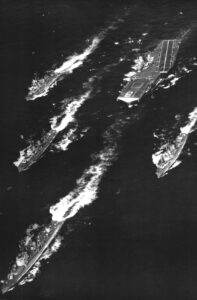 In October she became flagship of Task Group Bravo, Atlantic Fleet supported by shore-based seaplane patrol aircraft. She started a cruise on 26 November in the North Atlantic, back on 13 December 1958 and made another in 1959 along the Eastern Seaboard. On 18 August 1959, an helicopter engine exploded while being tested in hangar and the fire needed 2hours to be controlled. Since she had nuclear weapons on board the magazine was nearly flooded by precaution. On 27 February 1960, she was overhauled at Boston and by mid-July, sailed to the South Atlantic, then off Congo, supporting the UN airlift, back on 11 August.
In October she became flagship of Task Group Bravo, Atlantic Fleet supported by shore-based seaplane patrol aircraft. She started a cruise on 26 November in the North Atlantic, back on 13 December 1958 and made another in 1959 along the Eastern Seaboard. On 18 August 1959, an helicopter engine exploded while being tested in hangar and the fire needed 2hours to be controlled. Since she had nuclear weapons on board the magazine was nearly flooded by precaution. On 27 February 1960, she was overhauled at Boston and by mid-July, sailed to the South Atlantic, then off Congo, supporting the UN airlift, back on 11 August.
On 9 January 1961, her east coast routine was cut by a 3-month Mediterranean cruiseoff Sicily, Sardinia, France and spain, back on 1 September followed by overhaul. In 11–18 January 1962 her East Coast routine was diverted to Bermuda on 24–31 January and 18 February she sailed to Portsmouth, Rotterdam, Greenock, Plymouth, Kiel (first aircraft carrier there) Oslo, Reykjavík, and when backk Argentia, then Boston on 16 June. From August through October East Coast and a call for the Cuban blockade.
In 1963 same routine Virginia Capes and Caribbean, hosting on 21 March, President Kennedy. Later she was on station off Bermuda as backup recovery (Mercury space mission). By the fall of 1963 she had SBC-144 FRAM at Boston.
From September 1964 she made another Med Tod. In June 1965 she recovered Gemini IV James McDivitt and Ed White. On 20–21 August she took part in joint training with German and French forces. On 16 to 18 December, this was Gemini VI-A and Gemini VII. On 24 January 1966 she trained off Puerto Rico whe a storm caused structural damage, repaired in Boston on 18 February until 7 March. In joint exercises in the Narragansett Bay a TV crew arrived on 21 March, staying to film material for Armed Forces Day.
On 27 March, Doctor Ernst Lemberger, Austrian Ambassador visited her. On 18 April she carried gurst of the Secretary of the Navy to Guantanamo Bay, Cuba and back on 6 May. Later she recovered Gemini IX. She took part on ASWEX III from 20 June through 1 July 1966 and ASWEX IV until 5 August. From 19 September to 4 Octobe she had a hunter/killer training with RCAN aircraft embarked.
She took part in the Gemini XII recovery (5-18 November 1966) and took part in Lantflex-66 (100 US ships).
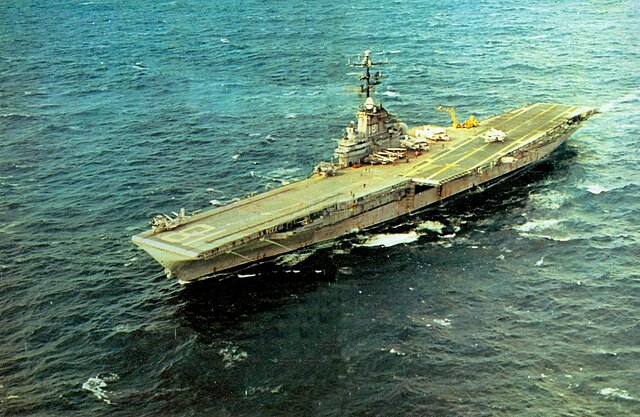
She started a new career as qualification duty ship from 24 January to 26 February 1967 in the Gulf of Mexico and off Florida celebtrating her 58,000th landing on 10 February 1967. She was in New Orleans for Mardi Gras 4–8 February, Pensacola, Mayport, and Boston, then Springboard operations in the Caribbean. On 24 March she collided with the oiler Salamonie at sea in RAS. She had a new overhaul at Boston Naval from 21 April 1967 until early 1968, took part in Fixwex C off Bermuda, made qualifications for students pilots from NAS Jacksonville but collided with USS Truckee in another RAS. HP became Quonset Point from 10 August and she made a northern European tour in the Firth of Clyde, Hamburg, Lisbon, in TG 87.1, and NATO Exercise Silvertower. On 25 October 1968 she entered the Mediterranean and joined TG 67.6 and back to Quonset Point.
In 1969 she trained with White Task Group Bermuda and departed for Europe on 1 April 1969, Exercise Trilant with Spain and Portugal. Later she was flagship for TF 87 and was at the NATO review by Queen Elizabeth and Prince Philip. Back home in 1970, Quonset Point, she had travelled 40,000 mi (60,000 km) and over 265 days. After a 6-week overhaul on 9 January she made another Atlantic deployment via Lisbon (25 May 1970), NATO Exercise Night Patrol, Rota, Copenhagen, shadowed by Soviet naval ships and aircraft and crossed the Arctic Circle.
On 13 July 1970 she was in Hamburg, opened to 15,000 visitor. After Edinburgh and Glasgow she was off Norway on 10 August and Oslo, Plymouth and back to Quonset Point on 8 September.
By January 1971, she carried the Commander, ASWGRU 2, CVSG-54 and Detachment 18, fleet Training Group to Cuba, Bermuda, and the Mediterranean for National Week VIII exercises. On 12 February, she carried Secretary of the Navy John Chafee and Cdr 6th Fleet Vice Admiral Isaac C. Kidd Jr. Next was another National Week exercise in February with USS John F. Kennedy to Gibraltar, trailed by Soviet ships to the Strait of Sicily. She was back home on 3 March.
May 1972 saw her at ex. Exotic Dancer and hosting an ABC television team, then Exercise Rough Ride off Bermuda up to Halifax and back at Quonset Point on 2 July 1971, then Exercise Squeeze Play IX, training with the East Coast naval reserve air group off Mayport. On 23 September she was at the Exercise Lantcortex 1-72 and more traininng between Bermuda, Mayport, Norfolk and back on 4 November. Net she was overhaul at Newport News until 22 November. She was prepared for decommissioning, on 1 July 1972. She was was sold on 21 May 1973, scrapped at Kearny.
 USS Hancock (CVA/CVS-19)
USS Hancock (CVA/CVS-19)
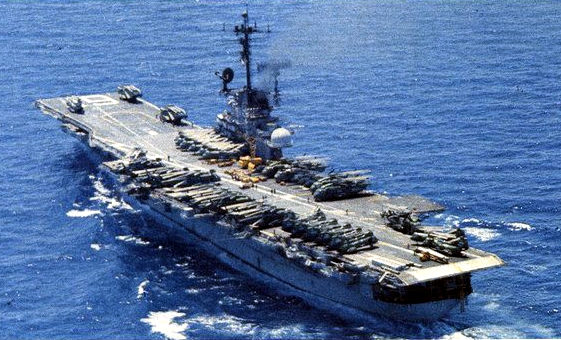
Albeit she arrived later and earned 4 battle stars in the Pacific she made for it with 13 battle stars in Vietnam. USS Hancock’s new career started after she was decommissioned in reserve fleet at Bremerton, and reactivated for her SCB-27C conversion at Puget Sound until 15 December 1951 as CVA-19, recommissioned on 15 February 1954 under Captain W. S. Butts, first with jet capable steam catapults at a cost of $60 million ($681 million today). She sailed to San Diego and left on 7 May 1954 making the first steam catapult launches along the Pacific coast, testing the Regulius and Cutlass and joining in August 1955 the 7th Fleet off Okinawa.
Back on 15 March she had her SCB-125 conversion, recom. 15 November 1956, local training until 6 April 1957, and sailed for the Far East, back to San Diego on 18 September 1957 and again away from 15 February 1958, present in the Quemoy and Matsu affair in August 1958 and overhauled at San Francisco on 2 October. August 1959 saw her back off Laos, and home by 18 January 1960, the testing the Communication Moon Relay project, then another WestpPac from August, and back to San Francisco in March 1961, Puget Sound overhaul. On 2 February 1962 she was in South China Sea about Laos and South Vietnam tensions and off Quemoy and Matsu in June, Okinawa and back on on 7 October, then off sea agains for the Pacific on 7 June 1963 for exercises off South Korea, South Vietnam after the coup of President Diem. She had a modenrization back at Point Naval Shipyard and back to the Pacific on 21 October, Yankee Station, Gulf of Tonkin, active until back home in the spring of 1965. She was back in Vietnam from 16 December, winning a Navy Unit Commendation.
Back to Vietnam early in 1967 she made strikes, then back to Alameda on 22 July and in the summer of 1969, same, when in July, in pre-deployment night landing she had an F-8 came crasing into her stern, destroying part of the deck as well. After repairs and back at Yankee station she launched strikes with USS Ranger and USS Oriskany south of the 19th parallel and took part in Operation Freedom Bait. She was relieved and alternated with Ranger and Kitty Hawk until 10 May 1971, the relieved by Midway. She was back with USS Coral Sea by 30 March 1972 and during the NVA invasion she multiplied sorties during Operation Freedom Train until the end of April from VA-55, VA-164, VF-211 and VA-212.
On 17 March 1975 she offloaded her air wing CAG 21 at Subic Bay, and embarked USMC heavy duty Squadron HMH-463 (25 CH-53, CH-46, AH-1J, UH-1E helicopters) and then the other half of CAG 21 fore more helicos at Subic Bay, supporting Amphibious Ready Group Bravo off Vung Tau in April and Amphibious Ready Group Alpha in the Gulf of Thailand for the evacuation of Operation Eagle Pull of Phnom Penh (12 April) and Operation Frequent Wind of Saigon on 29–30 April. She was soon back home. USS Hancock was decommissioned on 30 January 1976, stricken on the 31st, sold for scrap at DRMS on 1 September 1976.
 USS Bennington (CVA/CVS-20)
USS Bennington (CVA/CVS-20)
USS Bennington stayed in reserve for four years, reactivated on 29 October 1950, and modenrized at New York Naval Shipyard under SCB-27A modernization for two years, CVA-20 from October 1952, recommissioned on 13 November under Captain David. B. Young. The ceremony was attended by Secretary of the Navy Dan A. Kimball and Rear Admiral Roscoe H. Hillenkoetter. After carrier qualifications for Marine Attack Squadron 211 she saw the first jet landing, an F9F-5 Cougar and she moved to Guantanamo Bay for 11 weeks shakedown training with CVG-7. On 27 April she had a boiler explosion, which killed 11 men, but was repaired at Guantánamo Bay. On 7 May she was ready and sailed to New York via Norfolk to disembark her air group.
She was ported to Naval Air Station Quonset Point until mid-September and took part in NATO Operation Mariner until 4 October, and she sailed to Gibraltar for her first Mediterranean ToD with CVG-7 until 16 February 1954. In April she made carrier qualifications off Mayport, embarked ATG-181 on 22 May but at 06:00 on 26 May, smoke erupted from Hangar Bay 1 with two general fire alarms sounded followed by explosions which rocked her as the port side catapult accumulator burst, releasing vaporized lubricating oil catching an heat source. Her entire air group was evacuated, and she made it back to Quonset Point, then in New York for extensive repairs. This was the most serious peacetime accident yet on an Essex class, with 103 officers and men dead, 200+ injured. The court of inquiry concluded it was due to hazards related to hydraulic catapults and this drove a push to discard hydro-pneumatic catapults for steam-driven ones on all carriers.
She received also the SCB-125 modernization, done by 11 March 1955. From 1 August 1955, she joined CarDiv 2 with USS Lake Champlain and started operations from 25 April off NS Mayport, with post-overhaul shakedown, training in the West Indies with ATG-201. She was transferred to the Pacific via rounding the Cape Horn, to NS San Diego on 20 October. For nine years, she divided her time between the west coast and 7th Fleet with five deployments in the winter winter 1955 to 1958 with ATG-201 and ATG-181. On 7 May 1957, while in Sydney for Coral Sea Day celebrations University students dressed as pirates “captured her”, making an announcement.
She made another deployment from August 1958 to January 1959 with ATG-4 notably off Taiwan, Quemoy and Matsu, Second Taiwan Strait Crisis (awared the Expeditionary Medal) and latr back home the Navy wanted her as an ASW carrier only. On 30 June 1959 she became CVS-20 and embarked CVSG-59, which she carried for her 4h Far East ToD between October 1960 and May 1961, seeing the Laotian crisis and winning an Armed Forces Expeditionary Medal. Back home she helped in the Christmas flood of 1964, relief, using its twenty Marine helicopters.
Bennington’s final 7 years of service was for the Vietnam War. The Tonkin Gulf incident in August er her staying through October and November. On 18 May 1966, while cruising off of San Diego she tested the experimental LTV XC-142 making 44 short takeoffs and landings and was setup as prime recovery vessel for Apollo 4 from 9 November 1967. In the Gulf of Tonkin she provided ASW cover for Task Force 77 and recce for all ships in the vicinity and SAR for downed aviators until 21 April, the she sailed for Australia (Coral Sea anniversary). Se was back in San Diego on 23 May 1967.
She made her final deployment on 30 April 1968 via Pearl Harbor (15 to 20 May) and Yokosuka. She was back in Long Beach on 9 November and on the 14th she entered Long Beach Naval Shipyard for a 5-month overhaul, being active from 30 April 1969 until January 1970. On 15 January she was decommissioned, Pacific Reserve, Puget Sound, stricken on 20 September 1989, sold for scrap on 12 January 1994 in India.
 USS Boxer (CVA/CVS-21, LPH-4, AS-201)
USS Boxer (CVA/CVS-21, LPH-4, AS-201)
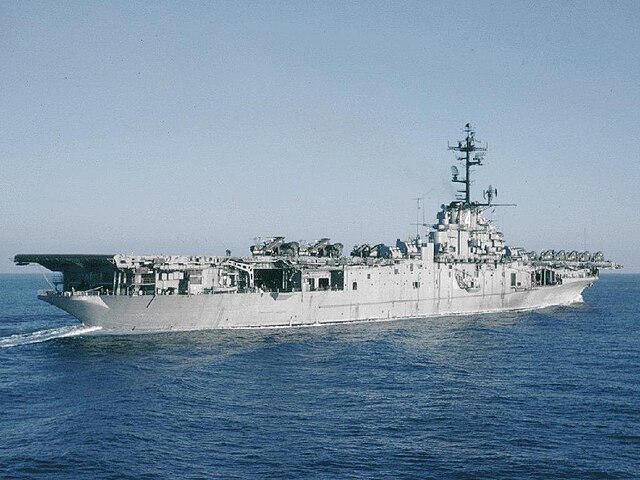
She entered service at the very end of the war, commissioned by April 1945 and arriving too late to see action. She was flagship for TF 77 and was in San Francisco on 10 September 1946 to embark CAG 19 with the F8F Bearcat for peacetime patrols off California in 1947. She made short cruises with US Navy Reserve and on 10 March 1948 made the first launch of the North American FJ-1 Fury and made a first tour in the Far East on 11 January 1950, 7th Fleet, stopping in South Korea and hosting president Syngman Rhee and back in San Diego on 25 June 1950 as the Korean War broke out. Overdue for an Overhaul she was to be compounded with an upgrade, but she was rushed back with supplies and aircraft and reinforce USS Valley Forge and HMS Triumph.
She made a record-breaking crossing of the Pacific from Alameda on 14 July 1950 to Yokosuka arriving on 23 July in 8 days and 7 hour with her decks and hangar full with 145 North American P-51 Mustangs, six Stinson L-5 Sentinels for the Far East Air Force, only keeping 19 Navy aircraft and she also carried 1,012 Air Force support personnel and 2,000 tonnes of supplies, spare parts and ordnance taken from Air National Guard. She left on 27 July for California on 4 August breaking a new record of trans-Pacific cruise. Next she embarked CAG 2 (Vought F4U Corsair) on 24 August, with 110 aircraft aboard and en route, narrowly avoided Typhoon Kezia. She was the 4th carrier to arrive in Korea for active combat, joining the recently arrived USS Philippine Sea, but missed the Battle of Pusan Perimeter, taking however part in the Incheon landings, Operation Chromite on 15 September with her Corsairs in close air support. One reduction gear broke due to overdue maintenance but engineers ssolved the issue and she could steam at 26 knots.
Her support went on as the UN pushed into North Korea, and departed on 11 November for refit and overhaul. She missed the Chosin Reservoir Campaign, ground commander requested Boxer returning asap. With her propulsion problems fixed, she was back at San Diego, offloaded CAG 2 transferred to Valley Forge. She carried herself CAG 10 with Navy Reserve picked in Dallas, Glenview, Memphis, Olathe, with recalled reservist pilots and rushed to join TF 77, arriving on 29 March 1951, launching series of strikes on Korea, notably around “Point Oboe” off Wonsan. She went back home for R&R and returned from 8 February 1952 with CAG 2 (F9F from VF-24, F4U from VF 63/64, AD Skyraider from VF-65) tasked of strategic bombing over North Korea, and destroying the Sui-ho hydro-electric complex with Princeton, Bon Homme Richard and Philippine Sea’s CAGs.
On 5 August 1952 05:30, she had a fire broking out in the hangar when a fuel tank caught fire azd it raged for 4–5 hours until extinguished, making 8 dead, 1 missing, 1 gravely injured, 1 seriously burned, 70 overcome by smoke. 63 jumped over the side, all rescued. 18 aircraft were destroyed. She had to sail to for Yokosuka for emergency repairs in August and was back on the 28th to 2 September, steting radio guided Grumman F6F Hellcats with 1,000-pound (450 kg) bombs to targets (2 hits, 1 near miss). She later took part in a large bombing mission of an oil refinery near Aoji, and sailed for home on 25 September. In October she became officially CVA-21 but had missed any upgrades so far.
She was back instead in Korea on 30 March 1953 between bombing raids and close air support in final weeks of the war. For this service she won 8 battle stars. In 1951 she was shot in the movie “Submarine Command”. She made a tour of the Pacific in 1954 with USS Essex to the South China Sea, Indochina-Philippines in standoff during the battle Dien Bien Phu and made another in late 1955 and early 1956.
At last she was converted to an anti-submarine warfare carrier CVS-21, in an “austere” conversion far from the SBC programmed on her sisters. She made two more Westpac tours by late 1956 and early 1957, and back home she was the first to test new concept involving heliopters as a versatile ASW/assault vessel. In 1958, she became flagship in Operation Hardtack, nuclear weapons tests. Transferred to the Atlantic Fleet, she took the head of a new amphibious assault squadron with four LSTs equipped with helicopter platforms. The goal was to proved for rapid deployment of USMC personnel via helicopters and she was reclassified LPH-4 (for Landing Platform Helicopter) on 30 January 1959.
For the next 10 years she operated as such on the Caribbean and was deployed in the 1962 Cuban Missile Crisis. In 1964 she made a first Mediterranean tout with Operation Steel Pike (largest amphibious exercise in history).
On 29 August 1964 was sent relied to Haiti and the Dominican Republic after Hurricane Cleo. Sge also took part in Operation Powerpack and in 1965 she became a transport vessel for Vietnam, with 200 helicopters of the 1st Cavalry Division to South Vietnam for the first large scale airbone operations. She made another transport trip in 1966 with Marine Corps aircraft. From 26 February 1966, she became AS-201, and was requsitioned for the Apollo program and by March 1966, Atlantic prime recovery ship for Gemini 8. She was decommissioned on 1 December 1969, after 25 years of service, stricken, sold for BU on 13 March 1971.
 USS Bonhomme richard (CVA/CVS-31)
USS Bonhomme richard (CVA/CVS-31)
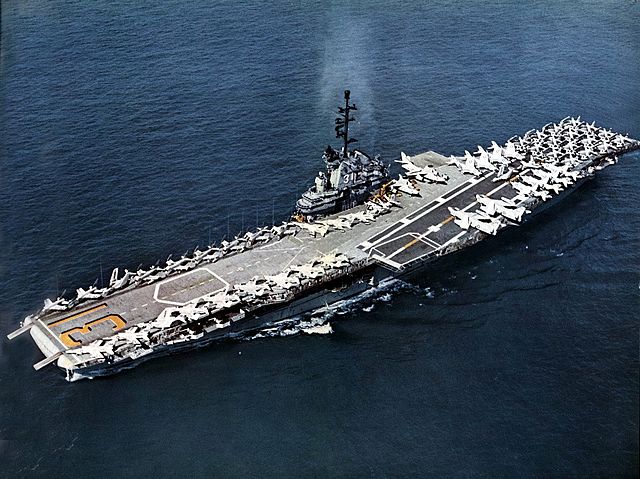
Commissioned on 26 November 1944 and just in time for the last Okinawa campaign and summer raids over Japan, USS Bonhomme Richard would have quite a nice wartime career as well, starting with the the Korean War from 25 June 1950. She had been mothballed, but was recommissioned on 15 January 1951, joining TF 77 off Korea on 29 May, launching the first air strikes with CVG-102 on 31 May, until 20 November 1951. She was back at San Diego in mid-December and back again on 20 May 1952 with CVG-7 arriving on 23 June for strikes against the Sui-ho Dam on 24–25 June and amphibious feint at Kojo in October and others until 18 December 1952. Sge sailed back to San Francisco (8 January 1953) as CVA-31, decommissioned on 15 May 1953 for a combo SCB-27C/125 modernization, completed by 31 October 1955, with sea trials, full recommission on 6 September and a serie of 7th Fleet deployments from 16 August 1956 with CVG-21, CVG-5 (1957) CVG-19 in 1958–1959, 1959–1960, 1961, 1962–1963, 1964, and 1965–66. While in the Indian Ocean she stopped in Bombay, and cruise with President Eisenhower aboard in 1959-1960.
She started the Vietnam war as flagship for Admiral George Stephen Morrison (father of The Doors lead singer Jim Morrison) and she made combat tours for six years. Her jet air park crossed Vietnamese MiGs and downing several. Carrier Air Wing 21 joined her in 1967 and CVW-5 in the last three deployments in 1968, 1969, and 1970. She was inactivated by late 1970, decommissioned on 2 July 1971, Reserve Fleet, Bremerton until sold for scrap in March 1992. She cumulated 1 battle star for World War II, 5 for Korea, 3 Navy Unit Citations, and a Presidential Unit Citation from President Richard M. Nixon.
 USS leyte (CVA/CVS-32, AVT-10)
USS leyte (CVA/CVS-32, AVT-10)
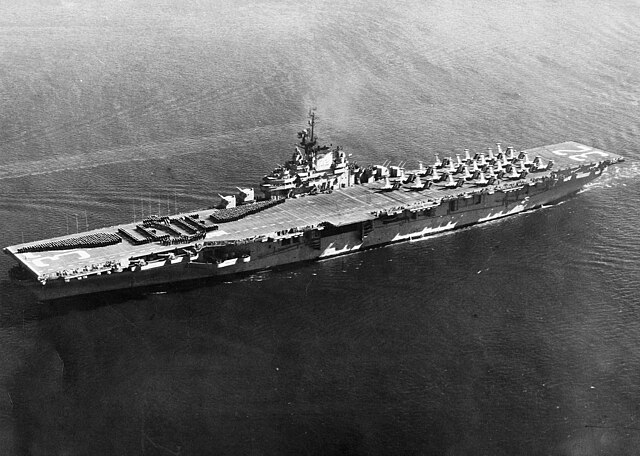
USS Leyte missed WW2 completely, being commissioned on 11 April 1946 and she joined the battleship USS Wisconsin on a good will cruise along South America and back on 18 November to complete shakedown. By 1948, she received an helicopter detachment with HO3S-1 for Operation Frigid in the North Atlantic. After fleet exercises in the Atlantic and Caribbean and three Mediterranean deployments in 1947, twice and 1949–1950, then May–August 1950 it was pretty uneventful apart a stand off Beirut on 13 August. On 6 September she joined Task Force 77 and started her Korean campaign. She had Sasebo as provisional base. First deployment was from 9 October to 19 January 1951, 92 days, 3,933 sorties with VF-32 Swordsmen (F4U Corsair and colored Ensign Jesse LeRoy Brown Kia 4 December 1950, which led to a movie in 2024. She had an overhaul in Nortfolk from 25 February 1951.
She then sailed for a 5th tour of duty with the 6th Fleet (Med) on 3 September, back on 21 December, and again from 29 August 1952 as CVA-32 and back on 16 February 1953 for deactivation, cancelled on 8 August, redesignated CVS-32 and converted as ASW carrier (austere). At 15:15 on 16 October 1953 her port catapult machinery room had an explosiion while berthed in preparations. The fire was extinguished at 19:57 but 37 men died, 28 injured.
Her Conversion was completed on 4 January 1954, she was Homeported at Quonset Point, Rhode Island, flagship CarDiv 18 for five years in ASW exercises on the eastern seaboard. By January 1959 she commenced preinactivation overhaul as AVT-10, decommissioned on 15 May 1959, Philadelphia, Atlantic Reserve Fleet until sold for scrap in September 1970. A short service indeed (1946-59).
 USS kearsage (CAV/CVS-33)
USS kearsage (CAV/CVS-33)
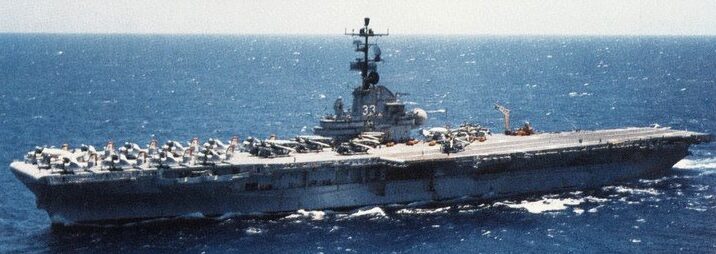
USS Kearsarge was homeported to Norfolk on 21 April 1946, and kept training on the East Coast-Caribbean making a midshipmen cruise on 7 June 1947 to britain and departing Hampton Roads on 1 June 1948 for 6th Fleet service, when departing she lost in heavy seas a 50-foot open launch on 31 May with 63 reovered but 12 crew and 10 Marines lost. Middle East crisis ensure constant service for Kearsarge until back to Quonset Point in 2 October. On 27 January 1950 she sailed to the West Coast via Panama, entered Puget Sound Navy Yard on 23 February, decommissioned for her SCB-27A conversion. Recommissioned on 15 February 1952 under Captain Louis B. French she made a shakedown, and left San Diego on 11 August for flight training near Peral Harbor and sailed for the Korean War. She joined Task Force 77 (TF 77) on the east coast of Korea and stayed five months, in constant operations, 6,000 sorties until late February 1953, and back to San Diego on 17 March as CVA-33.
She was used for the 1954 movie “The Caine Mutiny” and sailed for Korea on 1 July 1953.
She was soon nicknamed “Mighty Kay” “Rammin Rankin’s Krashbarge” and “The Mighty Kay-RUNCH” after three collisions with other ships like the liner SS Oriana leaving her almost unscaved. She alternated with the Formosa Straits due to threats of invasion of Taiwan and was back to San Diego on 18 January 1954, leaving again on 7 October, and be present during the Tachen Islands evacuation on 6–13 February (18,000 civilians and 20,000 military personnel), back home on 12 May.
In 1956–57, she had her SCB-125 modernization, and by the summer of 1958, became CVS-33 and sailed again for the Pacific on 5 September 1959 mettering off Japan a violent typhoon, providing relief to victims. She took part in SEATO exercises, 7th Fleet exercises and folded home on 3 March 1960, rescuing on her way 1,200 miles (1,930 kilometers) off Wake drifting Russians from a sunken landing craft. There intense ASW preparations before a new deployment on 3 March 1961 for the Laotion crisis with the 7th Fleet and back to Puget Sound on 1 November for SBC-144.
On 1 August 1962 she took part in Project Mercury recovering the capsule Sigma 7 on 3 October. Off Pearl Harbor on 29 April 1963 she retrieved this time Gordon Cooper on 16 May 1963 from his capsule Faith 7.
On 4 June she started her 8th cruise to the Far East and back to Long Beach on 3 December. Back in Asia again on 19 June 1964, Yokosuka, then South China Sea after the Gulf of Tonkin Incident, and 7th Fleet service until back to Long Beach on 16 December, overhaul, West Coast service (and filmed in 1965 Bob Hope “The Admiral”) and underway on 9 June 1966 via Hawaii and Japan and “Yankee Station” on 8 August until 24 October. She later stopped at Kuala Lumpur, anchored in the Strait of Malacca, sailed to Subic Bay and “Yankee Station” on 5 November and was back in San Diego on 20 December, then back again on 18 August but she stayed at Pearl Harbor for future action. However she was decommissioned on 13 February 1970, was stricken May 1973 and sold for scrap in February 1974.
 USS oriskany (1950)
USS oriskany (1950)
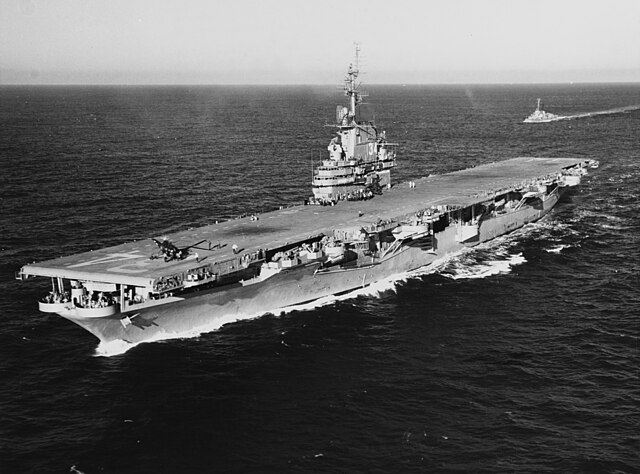
USS Oriskany departed New York on 6 December 1950 after her conversion, whiuch was also her completion. After carrier qualification off Florida she loaded CAG 1 to Cuba. After fixes at New York Naval Shipyard (6 March – 2 April) she embarked CAG 4 for training and was prepared at Newport, departing on 15 May 1951 for the Mediterranean, stopping in Italy and France, Greece and Turkey and off Tripoli, then back to Quonset Poin on 4 October 1951 and later a new overhaul at NYC completed by 15 May 1952, loading ammunition at Norfolk and reassigned to the Pacific Fleet via Rio de Janeiro, Cape Horn, Valparaíso and Lima to San Diego on 21 July, qualifying CAG 19 and sailing on on 15 September 1952 for Korea, making it in Yokosuka on 17 October, then joining Task Force 77 on 31 October. Her pilots downed two MiG-15 and damaged a 3rd on 18 November. She had some R&R on 11 Februar and was back on the line on 1 March 1953. On 6 March she had 3 men were killed, 13 injured when a general-purpose bomb from a F4U Corsair broke loose, rolled and detonated. On 29 March she had some R&R in Hong Kong and was back on 8 April, then sailed for home on 22 April via Yokosuka, arriving in San Diego on 18 May.
She was back after the truce on 15 October 1953. She provided air support for Marine amphibious assault exercises at Iwo Jima and was back home on 22 April 194 overhauled at San Francisco until 22 October, then local operations, tooking part in the movie “Bridges at Toko-Ri” and back at Yokosuka on 2 April 1955 until 7 September, ported to NAS Alameda on 21 September. She qualified newt CAG 9, and made another WestPac deployment. In San Francisco on 13 August 1956 she started her SCB-125A modernization until 7 March 1959. After shakedown with CAG 14 embarked she departed for the Pacific on 14 May 1960 and back on 15 December, San Francisco 5-month overhaul which included fitting an NTDS. She trained until 7 June 1962, and joined the Far East with CAG 16 embarked, then back on 17 December, another deployment from 1 August 1963, and back on 10 March 1964. After overhaul at Puget Sound she retrained CAG 16 and tested the new E-2 Hawkeye and hosted senior officers of eight allied nations.
She left San Diego on 5 April 1965 for anotehr WestPac, supprting ARVN troops with CAG 16, winning a Navy Unit Commendation from 10 May to 6 December 1965 making 12,000 combat sorties, dropping 10,000 tons (9,100 tonnes) of ordnance. She was back home on 16 December and back again on 26 May 1966, “Dixie Station” on 27 June and “Yankee Station”on 8 July, R&R in Subic Bay making 7,794 combat sorties. However on the morning of 26 October 1966, a fire erupted on her starboard side in the forward hangar bay. It rapidly spread to five decks, killing 44. The cause was later identified as a magnesium parachute flare erupting in the flare locker of Hangar Bay 1, beneath the flight deck due to human error. The seaman accidentally ignited it and in a panic, threw it into the weapons locker, igniting other flares. Crewmen jettisoned heavy bombs soon in reach of the flams, planes were frantically moved out and rescued pilots that jumped out. The fire was fought for three hours and USS Constellation and Franklin D. Roosevelt offered assistance. Five crew members were later court-martialed but acquitted. The flare design was changed to a safer design and better supervision setup.
Oriskany was back in Subic Bay on 28 October for initial repairs and transferring aircraft and she departed for San Diego, arriving on 16 November, entering the San Francisco Bay Naval Shipyard until 23 March 1967, and embarking CAG 16 which went home in between. She became flagship of CarDiv 9 in Subic Bay on 9 July and was at “Yankee Station” provding assistance on 26 July to USS Forrestal, also in flames. Future presidential candidate senator John McCain wa spilot aboard, shot down on 26 October 1967 and a POW until January 1973.
Oriskany was back home on 15 January 1968 after 122 days of combat with CAG 16 suffering the highest loss rate, 29 to combat damage, 10 to operational causes, 20 pilots killed, 9 taken prisoner for 9,500 missions, 181 air strikes in the “Hanoi–Haiphong corridor”. She had a new overhaul at San Francisco from 7 February over 8 month. By early 1969, she embarked CVW-19 with two squadrons of F-8J Crusaders (VF-191, VF-194) three squadrons of A-4 Skyhawks (VA-23, VA-192, VA-195) and others. She sailed east on April 1969, Gulf of Tonkin and stayed with this new air group until the end of the war in 1973.
The air campaign was suspended on 1 November 1968 but she lost a pilot on 20 July 1969 (hit by small arms fire). She made a second and 3rd period on the gun line then a 4th between 16 August and 12 September and a sweep off in October. On 20 September 1969, Captain John A. Gillcrist became captain as she made a 5th tour and 8 and 31 October, the aircraft carrier turned for home, arriving at Alameda via Subic Bay on 17 November. Long story short after a last overhaul at San Francisco to support A-7 Corsair II aircraft she sailed with CVW-19 with VF-191 and VF-194 (Crusaders) and VA-153 and VA-155 (A-7) for a 5th Vietnam deployment on 14 May 1970, at Yankee Station on 14 June. Her strikes extended to eastern Laos and her A-7 proved very usueful in night raids on the Ho Chi Minh trail. She lost two however. After three line periods and 5,300, a new captain Captain Frank S. Haak, she saw on 6 October an F8 crashing on her flight deck and exploding. Cost-cutting measures back home meant USS Orisany stayed alone off Vietnam. On 14 November she had another crash, one RF-8G from VFP-63. She also flew 14 diversionary sorties over North Vietnam on 21 November for the Son Tay POW rescue mission and retaliatory strikes. She was back at Alameda on 10 December 1970.
In January 1971, she received the SPN-41 all-weather carrier landing system and was underway on 14 May for her sixth Vietnam ToD focusing on strike operations in Laos, with four aircraft accidents. She also took part in Operation Proud Deep on 7–8 November on NVA airfields and had some R&R in Singapore. She was back at Alameda on 18 December. She departed for her 1972 tour on 5 June via Pearl Harbor and Guam, but had a collision with ammunition ship USS Nitro and was repaired at Yokosuka. Bacj at Yankee Station she went on striking targets in South Vietnam and joined Operation Linebacker II. With the Paris Peace Accords signed on 27 January 1973 she made a last deployment on 11–22 February, striking Laos and was back at Alameda on 30 March after 169 days of combat tour and ten battle stars for her Vietnamese service.
She was back to the Far East on 18 October 1973 but ventured on the Indian Ocean, meeting USS Hancock for training and she visited Mombasa in Kenya and back to Subic Bay, testing night flight operations and back to Alameda on 5 June 1974. Her 15th WESTPAC started on 16 September 1975, back on 3 March 1976. It was reported her poor material condition so she was listed for inactivation on 15 April 1976, decommissioned on 30 September 1976, placed in reserve at Bremerton, and Cogress opposed Reagan Administration’s proposals to reactivate her at a cost estimated at $520 million ($1.64 billion today). Stricken in 1989 and she was sold for Bu, later repossessed, eventually transferred on 5 April 2004 to Florida to be sunk as artificial reef, a first. The proud veteran, which obtained two battle stars in Korea and ten in Vietnam is now one of the top ten wreck diving sites in the world.
 USS antietam (CVA/CVS/CVT-36)
USS antietam (CVA/CVS/CVT-36)
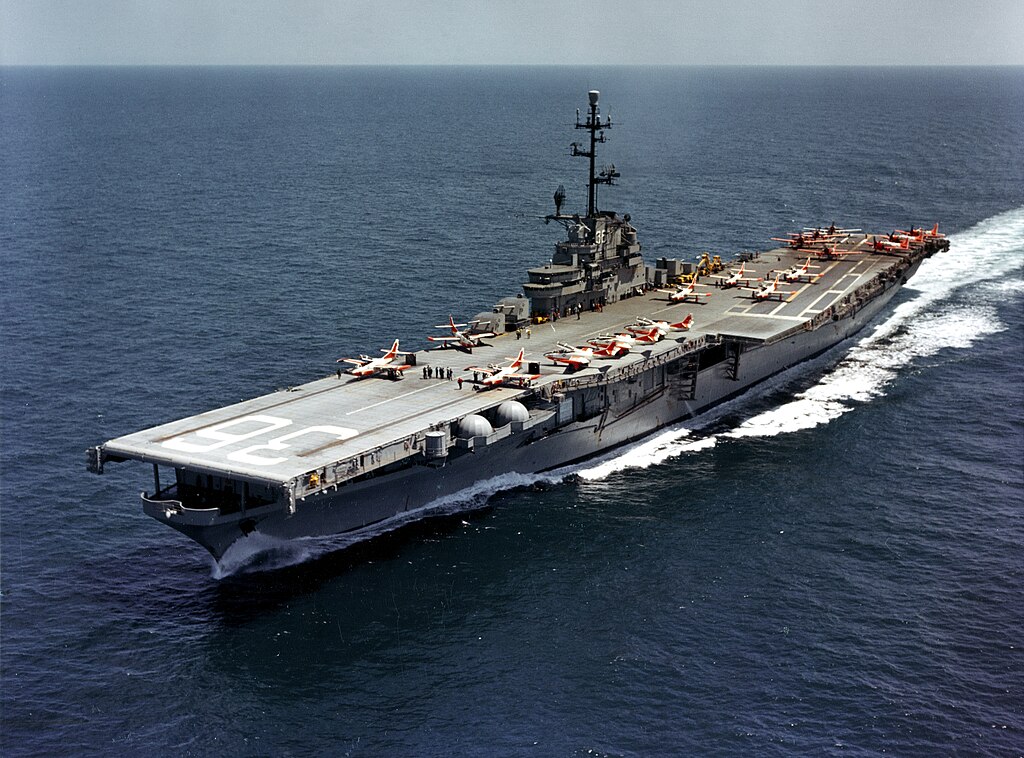
Decommissioned on 21 June 1949 after her short WW2 service, she was in reserve at Alamed until recommissioned on 17 January 1951 under Captain George J. Dufek and sailed for training to Pearl Harbor and back to San Diego, sailing for Korea on 8 September; making four combat deployments with TF 77 from the first between November 1951 to mid-March 1952, she amde 6,000 sorties. Back home she joined the Atlantic Fleet and was modified at New York Naval Shipyard as CVA-36 becoming by December 1952 the world’s first carrier with a true angled flight deck. She trained with the Royal Navy with both aircraft making touch and gos on British carriers as well to compare decks. Her F3Ds used RN VIPs catapults and properly landing as well. CVS-36 Antietam trained later for hunter/killer operations in 1955 and served with the 6th Fleet alternated with the eastern seaboard until the fall of 1956.
In the following years hse took part in NATO ASW exercises also making goodwill visits but ran aground off Brest, France, on 22 October 1956. While in Rotterdam, shge was ordered back to Egypt as the Suez crisis broke out. Next she trained with the Italian Navy. In 1957 she had advanced training at Naval Air Station Pensacola, HP Mayport, training new Navy pilots and after the cahhel was deepened she operated out of Pensacola as aviation training shi with two humanitarian interventions (Carla and Hattie). On 23 October 1962 Antietam replaced her at Pensacola so she was placed in reserve on 7 January 1963, Philadelphia, until May 1973, stricken, sold for BU on 28 February 1974.
 USS princeton (CVA/CVS-37/LPH-5)
USS princeton (CVA/CVS-37/LPH-5)
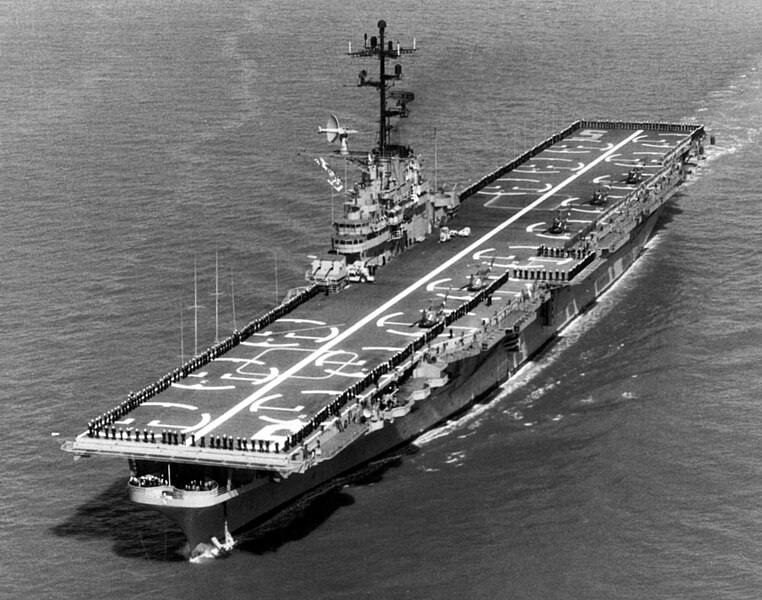
USS Princeton as LPH-5, assault helicopter carrier off Vietnam in 1965, note the deck painted helipads and still almost unmodified design.
Commissioned on 18 November 1945, Princeton (renamed after a lost CVL) missed WW2 entirely, and she was barely modernized. After shakedown off Cuba with CAG 81 embarked she trained with the Atlantic 8th Fleet until June 1946. Next sge was assigned to the Pacific Fleet, San Diego on 3 July 1946 and joined the 7th Fleet in the Marianas as flagship of TF 77. After the south Cjina sea she was posted in the Mariana Islands until February 1947. She embarked CAG 13 and helped evacuating civilians and military personal of Qingdao, back to San Diego by Dec. 1948. By 20 June she joined the Pacific Reserve Fleet. She was recativated for the Korean war but not modernized radically, being recommissioned on 28 August 1950 and needed urgently. She sailed with CAG 19 and launched 248 sorties from the Chosin Reservoir to Hungnam. She started to strike objectoves at Sunchon, Sinanju, Kachon, Hwachon Reservoir and interdiction missions. She was back in combat on 30 April 1952, and notably hit the hydroelectric complex at Suiho and round Pyongyang, factories at Sindok, Musan, Aoji, and Najin. By February 1953, she was back off Korea, launching “Cherokee” strikes until 27 July truce and departed for gome on 7 September.
As CVS-37 she was converted in Bremerton as antisubmarine/Hunter-Killer (HUK) carrier in the eastern Pacific for five years aletrnating with the West Coast, Western Pacific, Indian Ocean–Persian Gulf area. On 2 March 1959 she became the specialized amphibious assault carrier LPH-5. Her role was to bring to combat an entire battalion via helicopters, testing the concept of “vertical envelopment” by Marines behind enemy beach fortifications and provding logistics and medical support. She trained for this in 1959–1960 with Camp Pendleton, and made a training in Okinawan waters.
Thus routine went on for three years and by April 1962 she delivered Marine Corps advisors and helicopters to Sóc Trăng, Mekong Delta for South Vietnam. From September–November 1962, she became flagship of Joint Task Force 8 for Operation Dominic. By October 1964, she joined the Ready Group for operations against North Vietnamese and Viet Cong forces and by May off Chu Lai as she carried out her first true combat vertical envelopment.
She transported Marine Aircraft Group 36 to Vietnam in August. By February 1966 she relieved USS Okinawa as flagship for the Amphibious Ready Group and took part in operations Jackstay and Osage, later supporitng countless Search and destroy missions between provided transportation, medical evacuation, logistics and communication support. She took part in operation Deckhouse I, supported 1st Cavalry and 101st Airborne in Operation Nathan Hale, Operation Deckhouse II, Operation Hastings and sailed for home. She made another combat tour on 30 January–19 June 1967 and was instrumental over Gio Linh and Con Thien. In April she was at Operation Beacon Star (Khe Sanh) and Operation Shawnee. In May her air group operated along the Bến Hải River.
She had an overhaul and was back by May 1968 as flagship for Amphibious Ready Group Alpha, operations Fortress Attack III and IV, Proud Hunter, Swift Pursuit, and Eager Hunter and back home by December. By April 1969 she the prime recovery ship for Apollo 10, retreived on 26 May. On 30 January 1970 she was decommissiones, stricken, sold for scrapping by September 1972.
 USS shangri la (CVA/CVS-38)
USS shangri la (CVA/CVS-38)
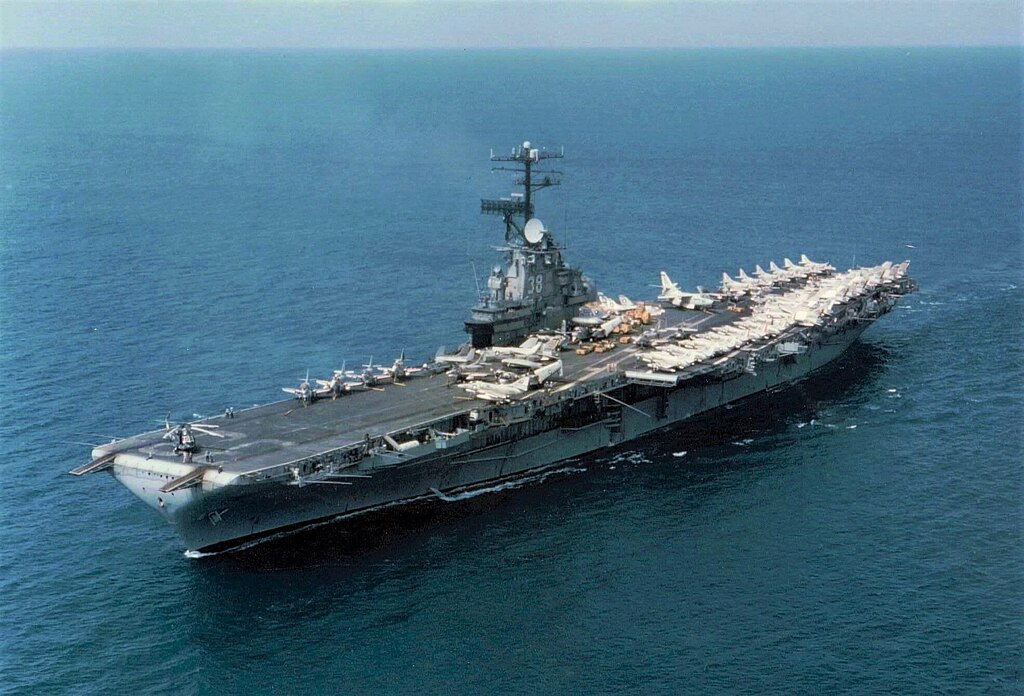
USS Shangri-La in her last deployment in January 1970 as CVS-38 in the Carribean.
USS was commissioned in 1944 but only arrived in Tokyo Bay on 16 September, two weeks after the surrender ceremony, stating until 1 October. She stayed with Task Unit 38.1.1. and San Pedro Bay, Long Beach, San Diego, and Bremerton, Puget Sound for availability back to to San Diego. In May 1946 she sailed to the Central Pacific for Operation Crossroads at Bikini Atoll. By March 1947, she sailed to Pearl Harbor, Sydney and back, decommissioned, Reserve Fleet at San Francisco on 7 November 1947, recommissioned on 10 May 1951, under Captain Francis L. Busey.
As CVA-38 in 1952 she was modernized at Puget Sound for two years at a cost of $7 million but when recommissioned on 10 January 1955 under Captain Roscoe L. Newman as second carrier with an angled flight deck the war in Korea was over. She still deployed to the Far East on 5 January 1956. On 16 March 1960 she was homeported to Mayport and the Atlantic fleet.
She soon made her first Atlantic deployment, NATO exercise off England. Next she showed the flag during trouble in Guatemala and Nicaragua. Between 1961 and 1970 she alternated between Mediterranean and western Atlantic.
She had another extensive ovrhaul at New York and from 15 February 1965 to 20 September 1965, made her last Mediterranean deployment with CAG 10 embarked, colliding with the destroyer Newman K. Perry off Sardinia. She had an extensive overhaul in the winter of 1965-spring 1966 at Philadelphia, and became the antisubmarine warfare carrier (CVS-38) before moving for the western Pacific via Rio de Janeiro, and Indian oceans to Subic Bay and for seven months launched combat sorties from Yankee Station. Before going home she stopped at Sydney, Wellington, Rio de Janeiro, and Mayport on 16 December 1940, but prepared for inactivation at Boston Naval Shipyard, decommissioned on 30 July 1971, Atlantic Reserve for 11 years, stricken on 15 July 1982, retaiend for MARAD (spare parts) and sold for BU on 9 August 1988 in Taiwan.
 USS lake champlain (CVA/CVS-39)
USS lake champlain (CVA/CVS-39)
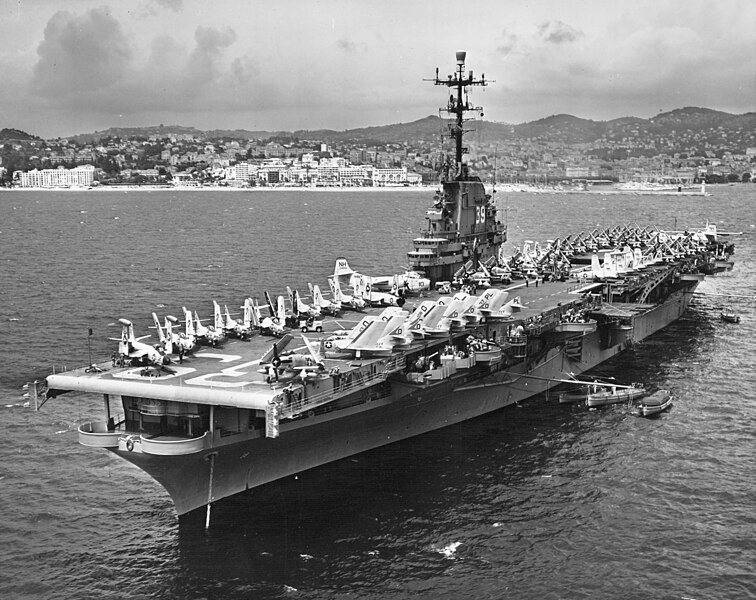
Lake Champlain off Cannes on 19 June 1957
Another carrier that missed WW2, USS Lake Champlain after her shakedown, visited to New York and Philadelphia, and was assigned to “Magic Carpet” from Norfolk for England on 14 October, Southampton to New York with speed record at 32.048 knonts in crossing on 26 November 1945 to Norfolk from Gibraltar over 3360.3 nautical miles in 4 days, 8 hours, 51 minutes, only beaten back by SS United States in 1952. She later laid up, reserve Norfolk on 17 February 1947 and reactivated in August 1950, converted to SCB-27A at Newport News, recommissioned on 19 September 1952, in shakedown until 25 December 1952. Based in Mayport she sailed on 26 April 1953 for Korea via the Red Sea, Indian Ocean and South China Sea, largest ever to transit the Suez Canal. She became upon arrival flagship of TF 77 and was off western Korea on 14 June. Apart usual strategic strikes and close air support her planes also escorted B-29 Superfortress. She made several deployment until the truce was signed on 27 July, relieved by USS Kearsarge on 11 October she headed for Singapore on 24 October and via Colombo, Port Said, Cannes, Lisbon she arrived at Mayport on 4 December 1953.
Her later years were routine, between Mediterranean, Atlantic NATO exercises. She was deployed off Lebanon, backing King Hussein in his Jordan coup. As CVS-39 she trained on eastern seaboard and helped Valencia devastated by floods on 14 October 1957. From Bayonne in New Jersey she departed on 8 February 1958 for another Mediterranean tour and had an overhaul. She made another trip to Spain, Denmark, and Scotland. By late 1958, after another Med TOD she was homeported to Quonset Point, Rhode Island.
She was later selected as prime recovery ship for Freedom 7, missiion off Cape Canaveral.
Next she carried NROTC Midshipmen and trained with the RCN at Halifax, stopped in Kingston, Jamaica, for the celebration of independence but from 24 October, she starter her watch for the “quarantine” of Cuba. After a new overhaul by September 1963, she was sent in relief of Haiti after Hurricane Flora.
On 6 May 1964, she collied with the USS Decatur underway in the Atlantic, Decatur being repaired in Norfolk.
Next Lake Champlain took part in Project Gemini after a trip to Spain and Huelva, Barcelona, Gibraltar and back to Quonset Point. It’s after her East Coast training she was designated on 19 January 1965, recovery ship for Gemini 2. A modernization FY 1966 was proposed and refused by SecNav Robert McNamara. On 29 August 1965 she was recovering Gemini 5. But was soon inactivated at Philadelphia Navy Yard, decommissioned on 2 May 1966, Reserve Fleet, considered for purchase by the Spanish Navy until choosing the way cheaper USS Cabot (CVL-28) as Dédalo. She was stricken on 1 December 1969, sold to DRMS, 28 April 1972.
 USS tarawa (CVA/CVS-40/AVT-12)
USS tarawa (CVA/CVS-40/AVT-12)
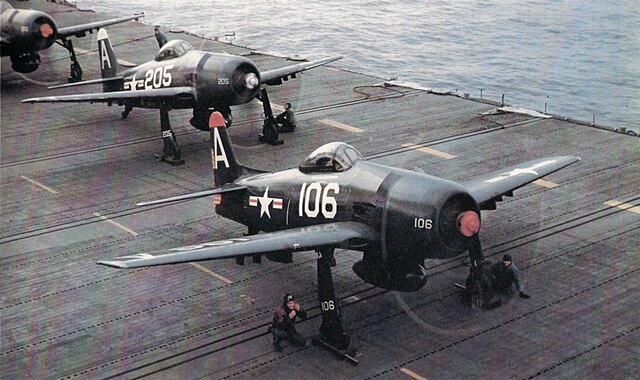
F8U Bearcats on USS Tarawa in 1958
Tarawa remained in Norfolk until 15 February 1946, made her shakedown off Cuba, visited New York, made her post-shakedown overhaul and left Hampton Roads for the west coast via Panama to San Diego, California on 15 July 1946. She made several deployments to the western Pacific via Pearl Harbor, Saipan, the Mariana Islands, Japan bring the typical route. Yokosuka and Sasebo were her advanced bases. At first she patroll off the northern coast of China, Tsingtao. Next year she trained off Kwajalein and took part Task Force 57 and trained with the legendary carriers of TF 38. She was back at San Francisco-San Diego in late 1948.
Next she started a cruise around the world via Pearl Harbor, Tsingtao, Hong Kong, Singapore, Ceylon (Colombo), Persian Gulf (Bahrain, Jeddah), Suez Canal, Port Said, Greece, Turkey, Crete, Gibraltar; across the Atlantic to Norfolk. Next were east coast-Caribbean exercises and an inactivation overhaul, decom. 30 June 1949 berthed with the New York Group of the Atlantic Reserve Fleet for 18 months, reactivated on 30 November 1950, recom. 3 February 1951 at Newport under Captain J. H. Griffin and never deployed in Korea. Instead she was a replacement for departed carriers from the 6th and 2nd Fleets. She was deployed still in Asia by the spring of 1954 after the war.
She had an overhaul at Boston as ASW aircraft carrier in 1955 and trained off Quonset Point and with Hunter-Killer Group 4, then she was at the 1956 Springboard exercise and on 30 September 1957 she visited Rotterdam. By August- September 1958 she was in TF 88 for Operation Argus nuclear tests.
She stayed with the Atlantic Fleet until the end her relatively cushy career. East coast from HP Quonset Point and Norfolk. On 1 May 1960 she was decommissioned and placed in reserve at Philadelphia, becoming AVT-12 in May 1961. On 1 June 1967 stricke, sold on 3 October 1968 for BU.
 USS valley forge (CVA/CVS-45/LPH-8)
USS valley forge (CVA/CVS-45/LPH-8)
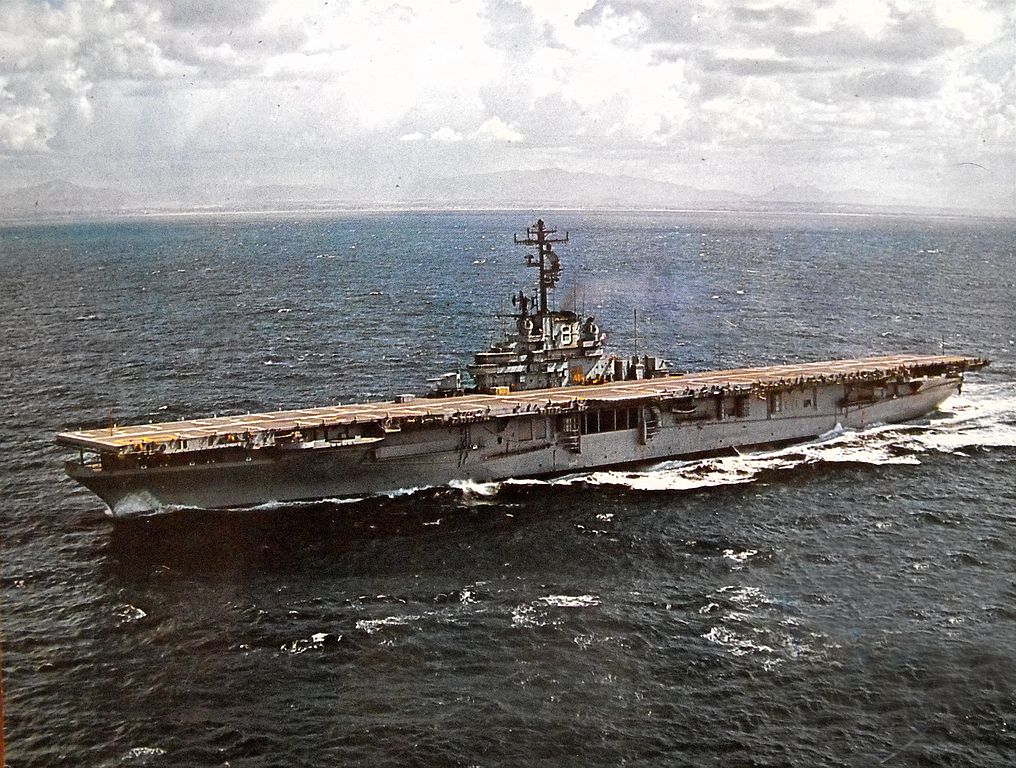
USS Valley Forge was commissioned on 3 November 1946, under Captain John W. Harris and she was presented by the Commonwealth of Pennsylvania the finest State Silver Service ever to the Navy mdade by Philadelphia silversmiths in 1904 and on the previous USS Pennsylvania. On 16 Jan 1947 she had her first aircraft landing, a Vought F4U Corsair for VF5B and later 96 aircraft and personnel of CAG 5 arrived. She started her shakedown on 24 January via Norfolk, to Cub-Panama until 18 March, Philadelphia for post-shakedown overhaul. She was assigned to the Pacific, to San Diego on 14 August. After exchanging air group for CAG 11 and training she departed with Rear Admiral Harold L. Martin, TF 38 for Pearl Harbor on 9 October and three months training with a trip to Australia in January 1948, visit to Sydney, and RAN training. She headed for Hong Kong, Tsingtao, Singapore, Trincomalee, stopped en route to Ras Tanura, Saudi Arabia in goodwill from the American government with a banquet given by Crown Prince of Damman. She entered the Suez Canal and joined the Mediterranean Fleet, USS Philippine Sea escorted by Rochester, Manchester, Dayton, and six destroyers for joint exercises. Next she was in Gibraltar, Bergen, even entering Bergen after a 25-mile (40 km) trip through the fjords and snow squalls. Air Group 11 flew a parade over Oslo, spelling the name of King Haakon VII.
Next she headed for Portsmouth, fired a 21-gun salute near to HMS Duke of York, HMS Victory and headed for New York, greeted by CNO Admiral Louis Denfield which initiated that World cruise. On 11 June she was back in San Diego. By July 1948 she obtained new squadrons with the Douglas A-1 Skyraider and McDonnell F2H Banshee, Grumman F9F Panther. After intensive training she was deployed for her first combat tour, in Korea. She sailed off on 1 May 1950, stopped at Kong harbor on 25 June, Subic Bay, Okinawa and On 28 June, she became flagship of the 7th Fleet, formed Task Force 77 escorted by the cruiser Rochester and six destroyers. The bedrock of USN operation here and start of the legendary TF 77. Her grooup was reinforced by cruiser HMS Jamaica, HMS Triumph and two British destroyers (Rear Admiral Andrews) and she launched a first strike on 3 July 1950. She targeted North Korean airfield at Pyongyang; leading the world’s first combat strike by jet aircraft.
Next she tried to stop the NK offensive near Pusan. Her F4U Corsairs (VF-53) intercepted two former lend-lease Soviet naval aviation 2 Douglas A-20 Havoc over the Yellow Sea and shot down one (the other fled) as the fleet prepared for the secret Incheon landing.
On 18 September 1950, she covered the landing at Inchon, and covered the advanced to the 38th parallel and into North Korea with CAG 5 making daily strikes, putting hard pressure on crews of the A-1 Skyraiders, F9F Panthers and F4U Corsairs with 5,000 combat sorties and 2,000 short tons of ordnance dropped between 3 July and 19 November 1950.
She was soon back at San Diego for overhaul, and headed back to Korea, carrying 100 planes and 10 helicopters as well as 1,000 short tons (910 t) of provisions and stores, 850 short tons (770 t) of ammunition loaded in three days to sail on 6 December. She arrived before Christmas 1950 and restarted strikes for three months against the advancing Chinese wit some 2,580 sorties, dropping 1,500 short tons of bombs alone. She sailed for home on 29 March and Bremerton, Puget Sound Naval for a major overhaul. Back to San Diego on 10 Aug 1951, she made a third Korean deployment, starting strikes on 11 December, destorying some 5,346 targets and bck home on 3 July 1952. It’s as CVA-45 that she departed for her 4th TOD by October 1952 under Captain Robert E. Dixon, dropping some 3,700 short tons of bombs and back to San Diego on 25 June 1953.
She had a west-coast overhaul, and was transferred to the Atlantic as CVS-45, refitted at Norfolk (but no still SBC modernization) and started 8th fleet ops by January 1954 focusing on antisubmarine warfare exercises until late 1960. In 1957 she tested the heliborne “vertical envelopment” and took part in LANTPHIBEX 1-58 with 1,400 Marines
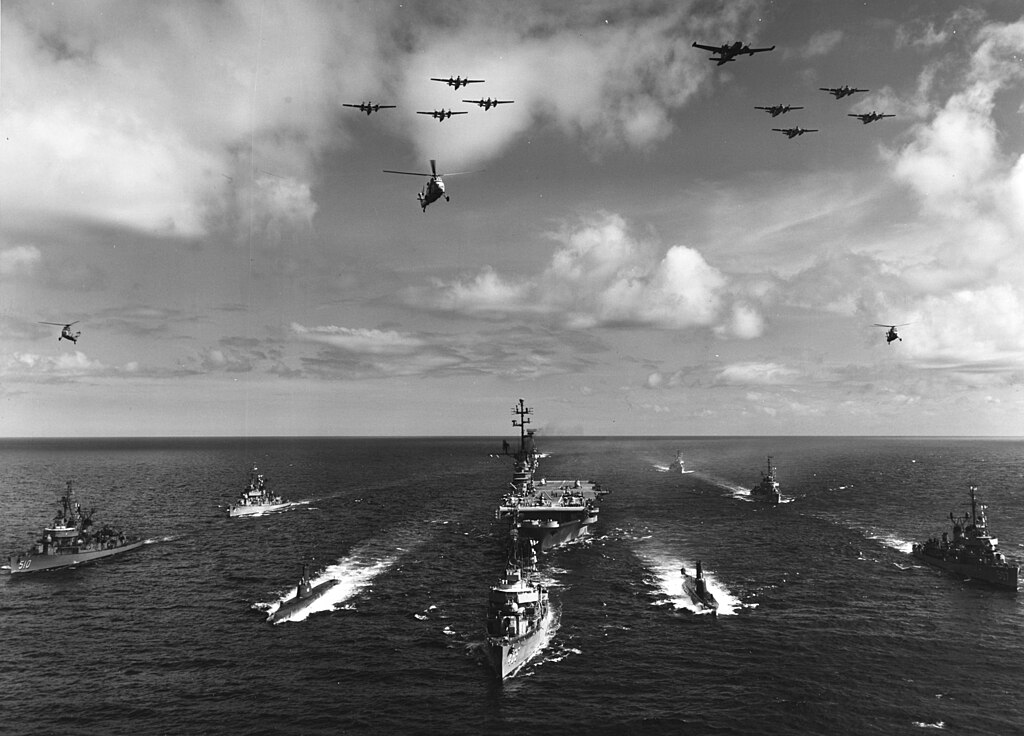
Task Group ALFA, formation portrait of the anti-submarine group’s ships and aircraft, taken during 1959 exercises in the Atlantic.
On 1 April 1958, she became flagship for Rear Admiral John S. Thach for Task Group Alpha with eight destroyers, two submarines, and carrying A-1 Skyraiders “guppies”, supported by land-based Lockheed P-2 Neptune as the first modern hunter-killer group. In the winter 1958–1959 she met heavy weather and nearly avoided a merchant ship but her flight deck was severely damaged and she was repaired in New York with replacement of a 30-by-90-foot (9.1 m × 27.4 m) section of deck from USS Franklin (CVS-13). TG Alpha was at sea until the fall of 1959, and again from 21 January 1960 she also took part in Operation Skyhook (stratospheric balloons for 22 miles (35 km) measurments) and back to ASW until the end of 1960.
She was recovery ship for Mercury-Redstone 1A capsule, Project Mercury. She later rescued tanker SS Pine Ridge in a storm.
She had a new 1962 refit at Norfolk to better perform as amphibious assault ship, reclassified as LPH-8 on 1 July 1961 and took part in Atlantic Fleet’s ready amphibious force, training in Hispaniola and rescuing nationals in the Dominican Republic coup.
Next she was assigned to the Pacific Fleet, 7th Fleet, cruised off the coast of Indochina, watched over Laos and was asked by Pdr Kennedy to send troops to avert a full-scale communist invasion of the country on 17 May and she departed in July, served until the end of 1962, and back to the west coast for 1963 amphibious exercises. She had a last refit at Long Beach anf FRAM overhaul until 27 January 1964, and made another WestPac via Okinawa, Hong Kong, Taiwan, trained with SEATO navies, being awarded the Battle Efficiency “E”.
After a trip back to Long Beach on 5 November she returned to Okinawa with marines and aircraft and started Vietnam operations by late 1965 as flagship of Amphibious Squadron 3 after exercises in the Philippines.
She soon took part in Operation Blue Marlin and Operation Dagger Thrust, and Operation Harvest Moon. With another MLarines bat. she was off South Vietnam on 3 January 1966 and on the 29th took part in Operation Double Eagle, remaining on station until 17 February and then Operation Double Eagle II until 26 February and some R&R at Subic Bay. She stopped at Đà Nẵng, and had an overhaul in California then back for operations off Đà Nẵng and home again by late 1966, new overhaul, extra training and Vietnam by November 1967 for Operation Fortress Ridge on 21 December until Christmas 1967, then Operation Badger Tooth near Quảng Trị.
Next was Operation Badger Catch on 23 January 1968 until 18 February, R&R at Subic Bay. She later became an “Helo Haven” for Marine helicopter units under pressure by PAVN. She took part in Operation Badger Catch II (6 March–14 April) and Operation Badger Catch III (28 April–3 June) and moved to Đà Nẵng for Operation Swift Saber on 7–14 June, Exercise Hilltop XX in July, giving her asset to USS Tripoli and sailing for home via Hong Kong, Okinawa, and Pearl Harbor to Long Beach on 3 August.
After overhaul, she made her last Vietnam deployment 30 January 1969 carrying Marine Sikorsky CH-53 Sea Stallion helicopters for transport squadrons in Vietnam. The carried the Commander, Special Landing Forces Bravo and a squadron of Marine Boeing Vertol CH-46 Sea Knight helicopters. On 10 March she too part in Operation Defiant Measure off Đà Nẵng until 18 March and R&R at Subic Bay, back to Đà Nẵng on 3 May. By early June USS Valley Forge was visited by Secretary of the Navy John Chafee , VADM W. F. Bringle, Commander 7th Fleet. Next she moved to Okinawa (16 June) and was back to Đà Nẵng on 8 July, supporting the northern I Corps area and Operation Brave Armada on 24 July over Quảng Ngãi Province until 7 August.
Back to Đà Nẵng she debark Marines and was visited by General Leonard F. Chapman, Jr. (Marine Corps), she sailed for Okinawa on 13 August and evaded a typhoon, she was in Hong Kong for R&R when on 22 August she learned about her next inactivation. She unloaded material at Đà Nẵng on 3 September, load others for sailing back to the United States after a trip to Yokosuka, arriving at Long Beach on 22 September. She unloaded all at Naval Weapons Station Seal Beach and San Diego and returned to Long Beach on 31 October, decommissioned on 15 January 1970, stricken, but used for the 1972 movie of science fiction “Silent Running” completely modified as a decor as “space freighter” for 8 months and she was sold on 29 October 1971 for scrap.
 USS phillipine sea (CVA/CVS-47/AVT-11)
USS phillipine sea (CVA/CVS-47/AVT-11)
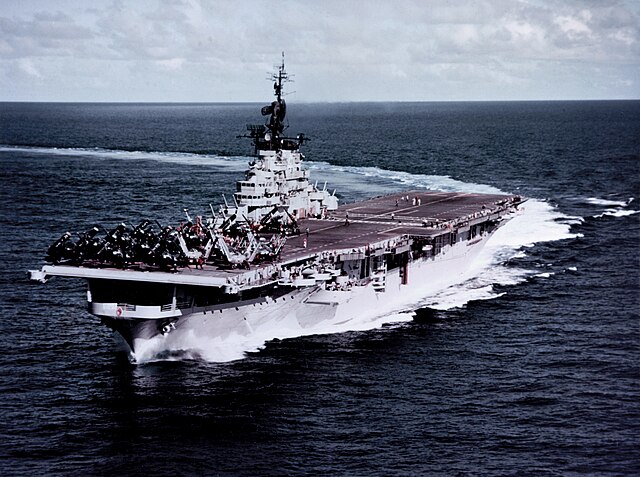
USS Philippine Sea was commissioned on 11 May 1946 under Captain Delbert Strother Cornwell at the Boston Navy Yard, proceeding to Quonset Point on 13 June but staying in reduced operational status due to missing crew until 23 September, making sea trials and embarking CAG 20 (F8F Bearcat, SB2C Helldiver, TBM-3E Avenger, 90 total) and sailed on 30 September for training and qualfications off Norfolk in October off Cuba plus abbreviated shakedown before being mobilized for Operation Highjump, prepared for great cold and disembarking CVG-20 at Boston and Norfolk sailing under RADM E. Byrd with six Douglas R4D-5 Skytrain transports on board as well as two Stinson OY-1 Sentinel liaison aircraft and a single Sikorsky HO3S-1 helicopter and supplies, sailing past Hampton Roads on 2 January 1947 for Antarctica via the Panama Canal, equator and meeting Task Force 68 660 miles (1,060 km) from Little America and the expedition commenced while she was back to port on 27 February.
Next she carried CAG 9 (Bearcats-Hellcat, Helldivers, Avengers, HO3S helicopters) for a proper shakedown cruise and ended her strials in July, refitted at Gravesend Bay, then NY Naval Shipyard and Bayonne until 15 November 1947 and more training until February 1948. She became flagship CarDiv 4 (Rear Admiral Ralph E. Jennings) and departed on the 20th fir the Mediterranean under VADM Forrest Sherman’s 6th Fleet, and theere making 8,534 flight hours, 85 hours night operations, back to to Quonset on 26 June. Tests went on, including in the North Atlantic in cold-weather and Arctic Circle training until 23 November 1948.
In January 1949, under RADM Joseph J. Clark she embarked CAG 7 and departed for another Med TOD from 4 January, joining USS Midway for training with the RN and back in late May, for an overhaul at Boston. She went on with fleet exercises in the North Atlantic and pilots qualifications in 1950. In April-May 1950 she made demonstration cruises for guests of the Secretary of the Navy and several Colleges. On 24 May 1950 she was transferred to San Diego, relieved by Oriskany and departed for the Far East in October 1950 and the war in Korea.
She sailed for Pearl Harbor and on 5 July embarked CAG 11 (4 squadrons Vought F4U Corsair) for Japan at full speed and arrived at Okinawa on 4 August, becoming flagship of CarDiv 1 as 3rd carrier to arrive in Korea joining her sister USS Valley Forge and HMS Triumph. As flagship of TF 77 on 5 August she started a cycle of daily air strikes notably for the Battle of Pusan Perimeter, Iri, Mokpo, and Kunsan with some 140 sorties a day and during the Great Naktong Offensive on 31 August (263 sorties by both carriers) and Battle of Masan.
Then she turned to strategic bombing from Seoul to Wonsan in September, Inchon and Wolmi-do before Operation Chromite. Strikes were done far inland and later close air support for the push to recapture Seoul, joined by USS Boxer.
The Chinese counterattack commenced by November 1950 from the Yalu River and heavy action meant supporting troops and delaying the advanced suring the retreat from the Yalu River with Panthers, Skyraiders and Corsairs notably trying to save X Corps at Chosin Reservoir. In all, 150,000 UN troops and civilians were evacuated and she teamed with Leyte and Princeton to defend against MiG-15 fighters with a curtain of 32 destroyers. On 25 February TF 77 command was transferred to Valley Forge and she retired into Yokosuka for R&R in the winter, exchanged CAG 11 for CAG 2 from Valley Forge on 28 March, whe she became flagship, VADM H. M. Martin, 7th Fleet CiC. She led the 7th Fleet through the Strait of Formosa to avoid the Chinese taking Taiwan. She was back at San Francisco on 9 June 1951 for refits, repairs, West Coast training and departed San Diego on 31 December 1951 for Pearl Harbor, Yokosuka with CAG 11 (5 refilled squadrons of F4U Corsair, 100 of them). She flew sorties against strategic targets, notably the Sui-ho Dam with Boxer, Princeton and Bon Homme Richard and back in August 1952.
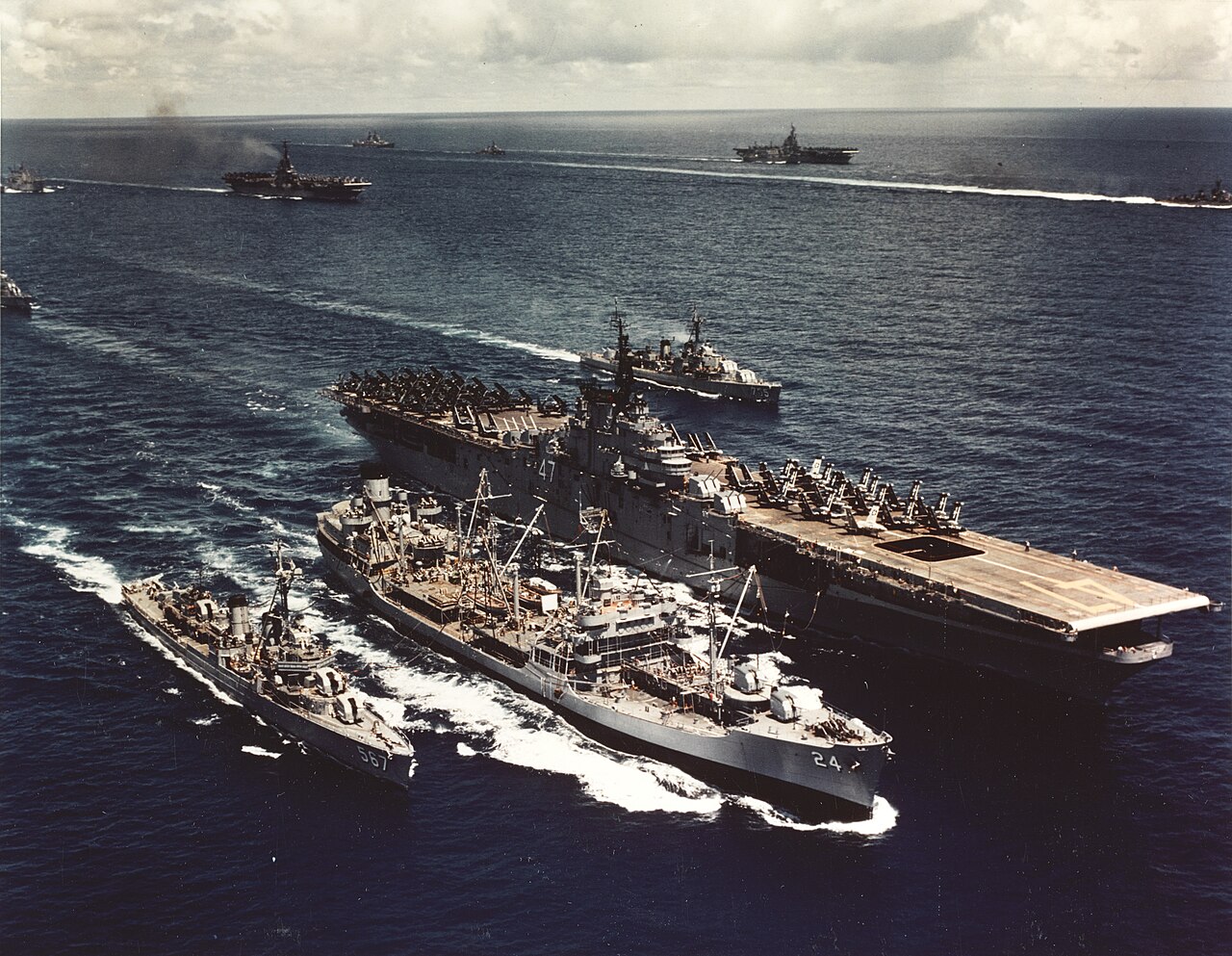
USS Platte (AO-24) refuels USS Philippines sea and escort USS Watts on 19 July 1955
She sailed with 5 Corsair Sqns from CAG 9 for a third WestPac from December 1952 notably off Korea and “round the clock” air sorties until armistice was signed (summer 1953) and back to her new HP Alameda NAS by 14 August 1953 and drydocked at Hunters Point, San Francisco for well needed overhaul until 9 January 1954. 12 March saw her sailing for a 4th tour from Subic Bay in CarDiv 3 with USS Hornet and around French Indochina as the batte of Dien Bien Phu developed. By July 1954 Chinese airplanes shot down a Douglas DC-4 passenger aircraft from Cathay Pacific Airways near Hainan Island, beieved to be a Taiwanese military airplane adn the carried search for survivors when its own Douglas AD Skyraiders were attacked by two Chinese fighter, so they returned fire and shot down both, which became the “Hainan Incident”. She was back to San Diego on 18 November and sailed back to the Far East on 1 April 1955 with CAG 2 (VF-123, VF-143, VA-55, VF-123 with the F9F-2 Panther, VF-143 with the Grumman F9F-6 Cougar, VA-55 with the AD-6 Skyraider) stopping in Hong Kong, Keelung and Formosa. As a VCS later she received 24 S2F Tracker and HSS-1 Seabat helicopters when back in San Diego on 23 November 1955. 1956 was routine, after an overhaul.
In March 1957 she departed for the far east for two months and back to San Diego, later in November she looked for Pan Am Flight 7. In January 1958 she made her last WestPac, back on 15 July and started inactivation, decommissioned 28 December 1958, Reserve of Long Beach, AVT-11 by 15 May 1958, stricken 1 December 1969, sold 23 March 1971 for BU. Her short career without proper modernization still presented 12 years service, 9 battle stars in Korea, 82,000 launches, 33,575 catapult shots, 82,813 landings.
Read More/Src
Books
Links
seaforces.org/
home.grandecom.ne cv09class.htm
navypedia.org
taskforce58.org
pacific.valka.cz/
thearmorylife.com/
usnavy.skyrocket.de/
en.wikipedia.org/ Fast_Carrier_Task_Force

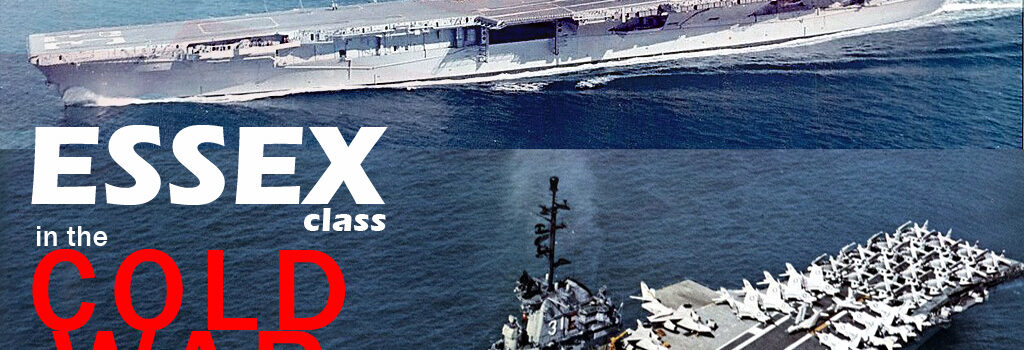
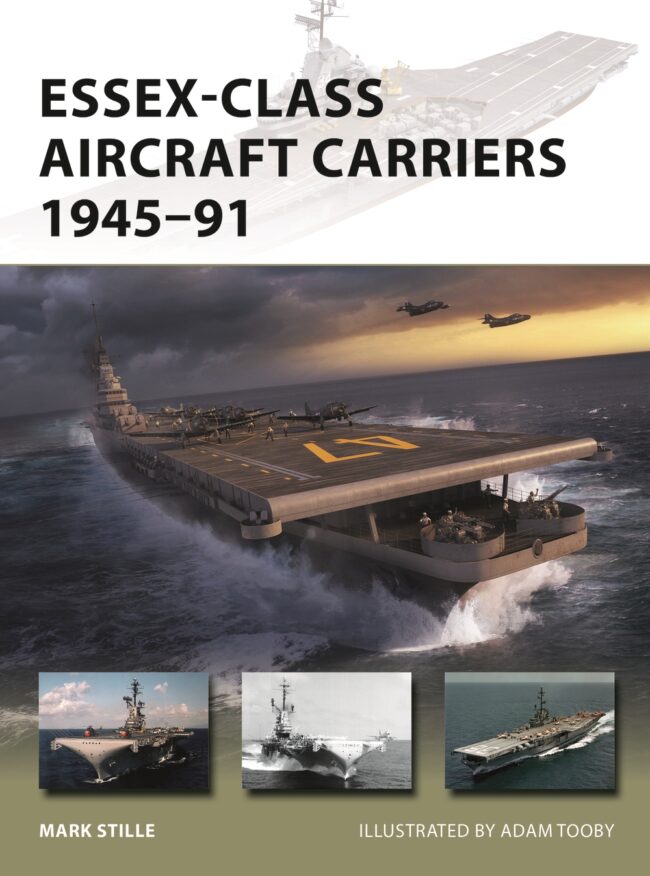
 Latest Facebook Entry -
Latest Facebook Entry -  X(Tweeter) Naval Encyclopedia's deck archive
X(Tweeter) Naval Encyclopedia's deck archive Instagram (@navalencyc)
Instagram (@navalencyc)





 French Navy
French Navy Royal Navy
Royal Navy Russian Navy
Russian Navy Armada Espanola
Armada Espanola Austrian Navy
Austrian Navy K.u.K. Kriegsmarine
K.u.K. Kriegsmarine Dansk Marine
Dansk Marine Nautiko Hellenon
Nautiko Hellenon Koninklije Marine 1870
Koninklije Marine 1870 Marinha do Brasil
Marinha do Brasil Osmanlı Donanması
Osmanlı Donanması Marina Do Peru
Marina Do Peru Marinha do Portugal
Marinha do Portugal Regia Marina 1870
Regia Marina 1870 Nihhon Kaigun 1870
Nihhon Kaigun 1870 Preußische Marine 1870
Preußische Marine 1870 Russkiy Flot 1870
Russkiy Flot 1870 Svenska marinen
Svenska marinen Søværnet
Søværnet Union Navy
Union Navy Confederate Navy
Confederate Navy Armada de Argentina
Armada de Argentina Imperial Chinese Navy
Imperial Chinese Navy Marinha do Portugal
Marinha do Portugal Mexico
Mexico Kaiserliche Marine
Kaiserliche Marine 1898 US Navy
1898 US Navy Sovietskiy Flot
Sovietskiy Flot Royal Canadian Navy
Royal Canadian Navy Royal Australian Navy
Royal Australian Navy RNZN Fleet
RNZN Fleet Chinese Navy 1937
Chinese Navy 1937 Kriegsmarine
Kriegsmarine Chilean Navy
Chilean Navy Danish Navy
Danish Navy Finnish Navy
Finnish Navy Hellenic Navy
Hellenic Navy Polish Navy
Polish Navy Romanian Navy
Romanian Navy Turkish Navy
Turkish Navy Royal Yugoslav Navy
Royal Yugoslav Navy Royal Thai Navy
Royal Thai Navy Minor Navies
Minor Navies Albania
Albania Austria
Austria Belgium
Belgium Columbia
Columbia Costa Rica
Costa Rica Cuba
Cuba Czechoslovakia
Czechoslovakia Dominican Republic
Dominican Republic Haiti
Haiti Hungary
Hungary Honduras
Honduras Estonia
Estonia Iceland
Iceland Eire
Eire Equador
Equador Iran
Iran Iraq
Iraq Latvia
Latvia Liberia
Liberia Lithuania
Lithuania Mandchukuo
Mandchukuo Morocco
Morocco Nicaragua
Nicaragua Persia
Persia San Salvador
San Salvador Sarawak
Sarawak Uruguay
Uruguay Venezuela
Venezuela Zanzibar
Zanzibar Warsaw Pact Navies
Warsaw Pact Navies Bulgaria
Bulgaria Hungary
Hungary

 Bundesmarine
Bundesmarine Dutch Navy
Dutch Navy Hellenic Navy
Hellenic Navy Marina Militare
Marina Militare Yugoslav Navy
Yugoslav Navy Chinese Navy
Chinese Navy Indian Navy
Indian Navy Indonesian Navy
Indonesian Navy JMSDF
JMSDF North Korean Navy
North Korean Navy Pakistani Navy
Pakistani Navy Philippines Navy
Philippines Navy ROKN
ROKN Rep. of Singapore Navy
Rep. of Singapore Navy Taiwanese Navy
Taiwanese Navy IDF Navy
IDF Navy Saudi Navy
Saudi Navy Royal New Zealand Navy
Royal New Zealand Navy Egyptian Navy
Egyptian Navy South African Navy
South African Navy






























 Ukrainian Navy
Ukrainian Navy dbodesign
dbodesign